Mohammad Reza Pahlavi
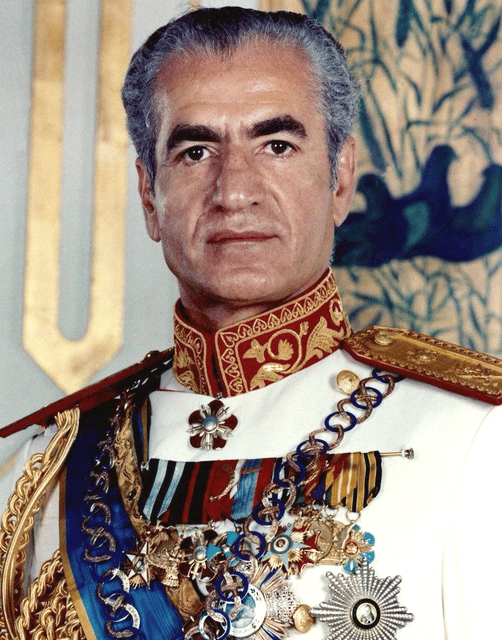
Mohammad Reza Pahlavi

| Mohammad Reza Pahlavi | |
|---|---|
| [1]Bozorg Arteštârân[2]Nixon%2C%20Kissinger%2C%20and%20the%20S]] | |
| Shah of Iran | |
| Reign | 16 September 1941 – 11 February 1979 |
| Coronation | 26 October 1967 |
| Predecessor | Reza Shah |
| Successor | Monarchy abolished |
| Born | 26 October 1919Tehran,Persia |
| Died | 27 July 1980(aged 60)Cairo,Egypt |
| Burial | |
| Spouse | |
| Issue | Princess ShahnazCrown Prince RezaPrincess FarahnazPrince Ali-RezaPrincess Leila |
| House | Pahlavi |
| Father | Reza Shah |
| Mother | Tadj ol-Molouk |
| Religion | Shia Islam |
| Signature | |
| Personal details | |
| Alma mater | |
| Military service | |
| Allegiance | Iran |
| Branch/service | Imperial Iranian Army |
| Years of service | 1936–41 |
| Rank | Captain |
| Commands | Army's Inspection Department |
| Full name | |
| Mohammad Reza Pahlavi | |
| Regnal name | |
| Mohammad Reza Shah | |
| **** | |
| Reference style | His Imperial Majesty |
| Spoken style | Your Imperial Majesty |
| Alternative style | Sir,Aryamehr |
Mohammad Reza Pahlavi (Persian: محمدرضا پهلوی, pronounced [mohæmˈmæd reˈzɒː ˈʃɒːh pæhlæˈviː]; 26 October 1919 – 27 July 1980),[3] also known as Mohammad Reza Shah (محمدرضا شاه), was the last King (Shah) of Iran from 16 September 1941 until his overthrow by the Iranian Revolution on 11 February 1979. Mohammad Reza Shah took the title Shahanshah ("King of Kings")[4] on 26 October 1967. He was the second and last monarch of the House of Pahlavi. Mohammad Reza Shah Pahlavi held several other titles, including that of Aryamehr ("Light of the Aryans") and Bozorg Arteshtaran ("Commander-in-Chief"). His dream of what he referred to as a "Great Civilisation" (Persian: تمدن بزرگ, romanized: tamadon-e bozorg) in Iran led to a rapid industrial and military modernisation, as well as economic and social reforms.[5][6]
Mohammad Reza came to power during World War II after an Anglo-Soviet invasion forced the abdication of his father, Reza Shah Pahlavi. During Mohammad Reza's reign, the British owned oil industry was briefly nationalised, under Prime Minister Mohammad Mosaddegh, until a UK and US -backed coup d'état deposed Mosaddegh and brought back foreign oil firms under the Consortium Agreement of 1954.[7] Under Mohammad Reza's reign, Iran marked the anniversary of 2,500 years of continuous Persian monarchy since the founding of the Achaemenid Empire by Cyrus the Great – concurrent with this celebration, Mohammad Reza changed the benchmark of the Iranian calendar from the hegira to the beginning of the First Persian Empire, measured from Cyrus the Great's coronation.[8] Mohammad Reza also introduced the White Revolution, a series of economic, social and political reforms with the proclaimed intention of transforming Iran into a global power and modernising the nation by nationalising certain industries and granting women suffrage.
Mohammad Reza gradually lost support from the Shi'a clergy of Iran as well as the working class, particularly due to his strong policy of modernisation, laïcité, conflict with the traditional class of wealthy merchants known as bazaaris, relations with Israel, and corruption issues surrounding himself and the royal family, and the ruling elite. Various additional controversial policies were enacted, including the banning of Communism and Marxism–Leninism including the Tudeh Party and a general suppression of political dissent by Iran's intelligence agency, SAVAK. According to official statistics, Iran had as many as 2,200 political prisoners in 1978, a number which multiplied rapidly as a result of the revolution.[9]
Several other factors contributed to strong opposition to the Shah amongst certain groups within Iran, the most significant of which were US and UK support for his regime, and clashes with leftists and Islamists.
By 1979, political unrest had transformed into a revolution which, on 17 January, forced him to leave Iran.
Soon thereafter, the Iranian monarchy was formally abolished, and Iran was declared an Islamic republic led by Ruhollah Khomeini (known in the West as Ayatollah Khomeini). Facing likely execution should he return to Iran, he died in exile in Egypt, whose president, Anwar Sadat, had granted him asylum. Due to his status as the last Shah of Iran, he is often known as simply "The Shah".
| Mohammad Reza Pahlavi | |
|---|---|
| [1]Bozorg Arteštârân[2]Nixon%2C%20Kissinger%2C%20and%20the%20S]] | |
| Shah of Iran | |
| Reign | 16 September 1941 – 11 February 1979 |
| Coronation | 26 October 1967 |
| Predecessor | Reza Shah |
| Successor | Monarchy abolished |
| Born | 26 October 1919Tehran,Persia |
| Died | 27 July 1980(aged 60)Cairo,Egypt |
| Burial | |
| Spouse | |
| Issue | Princess ShahnazCrown Prince RezaPrincess FarahnazPrince Ali-RezaPrincess Leila |
| House | Pahlavi |
| Father | Reza Shah |
| Mother | Tadj ol-Molouk |
| Religion | Shia Islam |
| Signature | |
| Personal details | |
| Alma mater | |
| Military service | |
| Allegiance | Iran |
| Branch/service | Imperial Iranian Army |
| Years of service | 1936–41 |
| Rank | Captain |
| Commands | Army's Inspection Department |
| Full name | |
| Mohammad Reza Pahlavi | |
| Regnal name | |
| Mohammad Reza Shah | |
| **** | |
| Reference style | His Imperial Majesty |
| Spoken style | Your Imperial Majesty |
| Alternative style | Sir,Aryamehr |
Early life
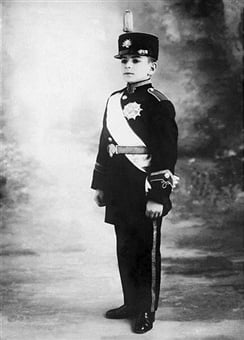
Mohammad Reza in 1930
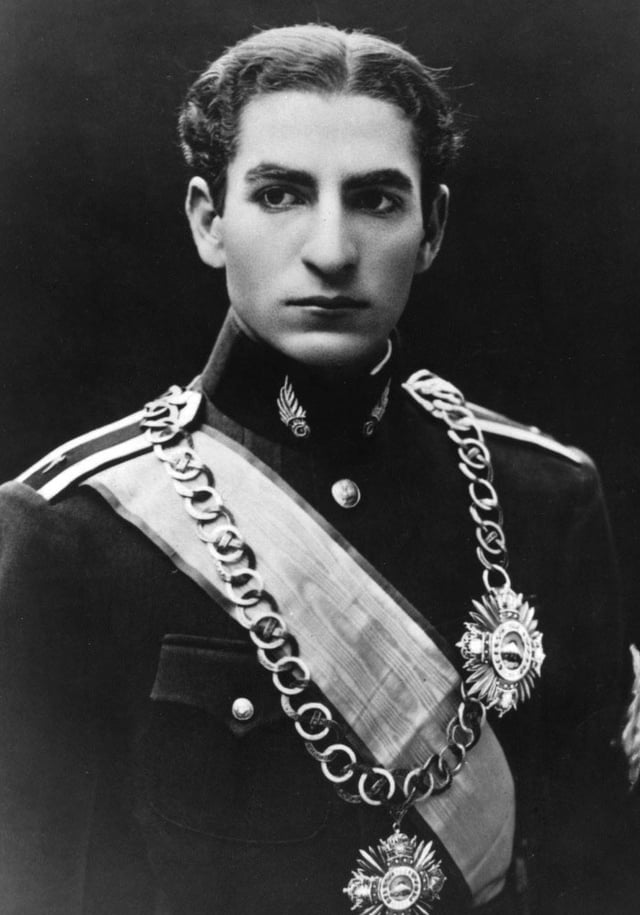
Crown Prince Mohammad Reza in 1939
Born in Tehran, to Reza Khan (later Reza Shah Pahlavi) and his second wife, Tadj ol-Molouk, Mohammad Reza was the eldest son of Reza Khan, who later became the first Shah of the Pahlavi dynasty, and the third of his eleven children. His father, a former Brigadier-General of the Persian Cossack Brigade, was of Mazandarani and Georgian origin.[10] His father was born in Alasht, Savadkuh County, Māzandarān Province. Mohammad Reza's paternal grandmother, Noush-Afarin, was a Muslim immigrant from Georgia (then part of the Russian Empire),[11]The%20Life%20and%20Times%20o]][[12]](https://openlibrary.org/search?q=Haddad-Adel%2C%20Gholam-Ali%3B%20%20et%20al.%20%282012%29.%20 [[CITE|12|https://openlibrary.org/search?q=Haddad-Adel%2C%20Gholam-Ali%3B%20%20et%20al.%20%282012%29.%20*The%20Pahl)Iran Caucasus Russo-Persian Wars or to Reza Khan's birth.[13] Mohammad Reza's mother, Tadj ol-Molouk, was of Azerbaijani origin, being born in Baku, Russian Empire (now Azerbaijan).
Mohammad Reza was born along with his twin sister, Ashraf. However, Shams, Mohammad Reza, Ashraf, Ali Reza, and their older half-sister, Fatimeh, were not royalty by birth, as their father did not become Shah until 1925. Nevertheless, Reza Khan was always convinced that his sudden quirk of good fortune had commenced in 1919 with the birth of his son who was dubbed khoshghadam (bird of good omen).[14] Like most Iranians at the time, Reza Khan did not have a surname and after the 1921 Persian coup d'état which deposed Ahmad Shah Qajar, he was informed that he would need a name for his house. This led Reza Khan to pass a law ordering all Iranians to take a surname; he chose for himself the surname Pahlavi, which is the name for the Middle Persian language, itself derived from Old Persian.[15] At his father's coronation on 24 April 1926, Mohammad Reza was proclaimed Crown Prince.[16]Shahanshah%3A%20The%20Study%20Of%20]][[15]](https://openlibrary.org/search?q=Milani%2C%20Abbas.%20 [[CITE|15|https://openlibrary.org/search?q=Milani%2C%20Abbas.%20The%20Shah%2C%20London%3A%20Macmillan%202011%2C)
Family
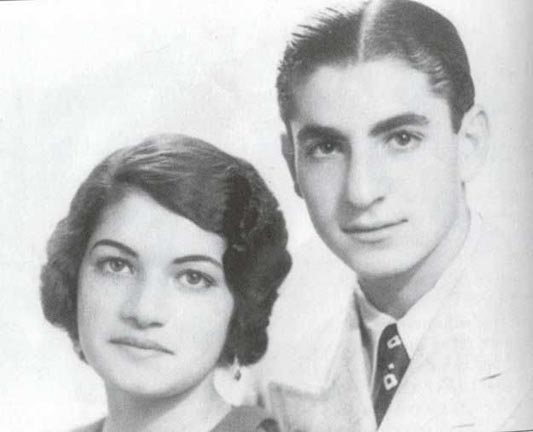
Mohammad Reza with his twin sister, Ashraf, in the 1940s
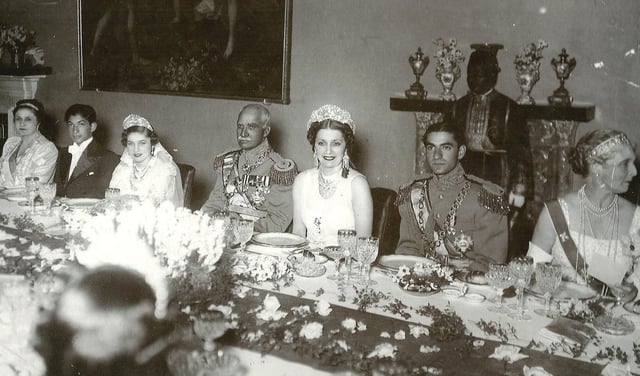
The Iranian and Egyptian imperial families after a wedding in Saadabad Palace, Tehran, 25 April 1939
Mohammad Reza described his father in his book Mission for My Country as "one of the most frightening men" he had ever known, depicting Reza Khan as a dominating man with a violent temper.[17] A tough, fierce, and very ambitious soldier who became the first Persian to command the elite Russian-trained Cossack Brigade, Reza Khan liked to kick subordinates in the groin who failed to follow his orders; growing up under his shadow, Mohammad Reza was a deeply scarred and insecure boy who lacked self-confidence.[17]
Reza Khan believed if fathers showed love for their sons, it caused homosexuality later in life, and to ensure his favourite son was heterosexual, denied him any love and affection when he was young, though he later become more affectionate towards the Crown Prince when he was a teenager.[15] Reza Khan always addressed his son as shoma ("sir") and refused to use more informal tow ("you"), and in turn was addressed by his son using the same word.[15] The Polish journalist Ryszard Kapuściński observed in his book Shah of Shahs that looking at old photographs of Reza Khan and his son, he was struck by how self-confident and assured Reza Khan appeared in his uniform while Mohammad Reza appeared nervous and jittery in his uniform standing next to his father.[21] In the 1930s, Reza Khan was an outspoken admirer of Hitler, though this was less because of any racism and anti-Semitism on his part, but rather because Reza Khan saw Hitler as someone much like himself, namely a man who had risen from an undistinguished background to become a notable leader of the 20th century.[22]The%20Fighting%20Never%20Stopped%3A%20A%20Co]]Reza Khan often impressed on his son his belief that history was made by great men such as himself, and that a real leader is an autocrat.[[22]](https://openlibrary.org/search?q=Brogan%2C%20Patrick.%20 [[CITE|22|https://openlibrary.org/search?q=Brogan%2C%20Patrick.%20*The%20Fighting%20Never%20Stopped%3A%20A%20Co) o liken him to a mountain, and throughout his life, Mohammad Reza was obsessed with height and stature, for example wearing elevator shoes to make himself look taller than he really was, often boasting that Iran's highest mountain Mount Demavand was higher than any peak in Europe or Japan, and he was always most attracted to tall women.[23] As Shah, Mohammad Reza constantly disparaged his father in private, calling him a thuggish Cossack who achieved nothing as Shah, and most notably the son almost airbrushed his father out of history during his reign, to the point that the impression was given the House of Pahlavi began its rule in 1941 rather than 1925.[17]
Mohammad Reza's mother, Tadj ol-Molouk was an assertive woman who was also very superstitious.
She believed that dreams were messages from another world, sacrificed lambs to bring good fortune and scare away evil spirits, and clad her children with protective amulets to ward off the power of the evil eye.[17] Tadj ol-Molouk was the main emotional support to her son, cultivating a belief in him that destiny had chosen him for great things, as the soothsayers she consulted had explained her dreams as proving just precisely that.[17] Mohammad Reza grew up surrounded by women, as the main influences on him were his mother, his older sister Shams and his twin sister Ashraf, leading the American psychologist Marvin Zonis to conclude it was "... from women, and apparently from women alone" that the future Shah" "received whatever psychological nourishment he was able to get as a child".[23]Majestic%20Failure%3A%20The%20Fall%20of%20the%20]]Traditionally, male children were considered preferable to females, and as a boy, Mohammad Reza was often spoiled by his mother and sisters.[[27]](https://openlibrary.org/search?q=Zonis%2C%20Marvin.%20 [[CITE|23|https://openlibrary.org/search?q=Zonis%2C%20Marvin.%20*Majestic%20Failure%3A%20The%20Fall%20of%20the%20) ith my brother that would nourish and sustain me throughout my childhood... No matter how I would reach out in the years to come-sometimes even desperately-to find an identity and a purpose of my own, I would remain inextricably tied to my brother... always, the center of my existence was, and is, Mohammad Reza".[23]
After becoming Crown Prince, Mohammad Reza was taken away from his mother and sisters to be given a "manly education" by officers selected by his father, who also ordered that everyone including his mother and siblings were to address the Crown Prince as "Your Highness".[15] The result of his upbringing between a loving, if possessive and superstitious mother and an overbearing martinet father was to make Mohammad Reza in the words of Zonis "... a young man of low self-esteem who masked his lack of self-confidence, his indecisiveness, his passivity, his dependency and his shyness with masculine bravado, impulsiveness, and arrogance", making him into a person of marked contradictions as the Crown Prince was "both gentle and cruel, withdrawn and active, dependent and assertive, weak and powerful".[23]
Education

Mohammad Reza entering Madrasa Nezam, a military school in Tehran, 1938
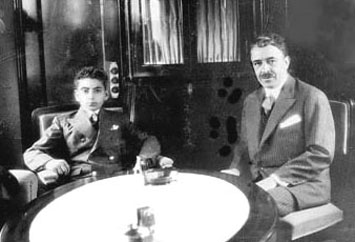
A young Mohammad Reza with Abdolhossein Teymourtash at the Institut Le Rosey in Lausanne, Switzerland, 1932
By the time Mohammad Reza turned 11, his father deferred to the recommendation of Abdolhossein Teymourtash, the Minister of Court, to dispatch his son to Institut Le Rosey, a Swiss boarding school, for further studies. Mohammad Reza left Iran for Switzerland on September 7, 1931.[30] On his first day as a student at Le Rosey in September 1931, the Crown Prince antagonised a group of his fellow students who were sitting on a bench in a park outside Le Rosey with his demand that they all stand to attention as he walked past, just as everybody did back in Iran, which led to an American student beating up Mohammad Reza, who swiftly learned to accept that no one would stand to attention wherever he went in Switzerland.[17] As a student, Mohammad Reza played competitive football, but the school records indicate that his principal problem as a football player was his "timidity" as the Crown Prince was afraid to take risks.[17] The Crown Prince was educated in French at Le Rosey, and his time there left Mohammad Reza with a lifelong love of all things French.[17] In articles he wrote in French for the student newspaper in 1935 and 1936, Mohammad Reza praised Le Rosey for broadening his mind and introducing him to European civilisation.[17] Mohammad Reza lost his virginity to a maid who worked at Le Rosey in 1935.[17]
Mohammad Reza was the first Iranian prince in line for the throne to be sent abroad to attain a foreign education and remained there for the next four years before returning to obtain his high school diploma in Iran in 1936.
After returning to the country, the Crown Prince was registered at the local military academy in Tehran where he remained enrolled until 1938, graduating as a Second Lieutenant. Upon graduating, Mohammad Reza was quickly promoted to the rank of Captain, a rank which he kept until he became Shah. During college, the young prince was appointed Inspector of the Army and spent three years travelling across the country, examining both civil and military installations.[16]Shahanshah%3A%20The%20Study%20Of%20]][[36]](https://openlibrary.org/search?q=Fardust%2C%20Hossein%3B%20Dareini%2C%20Ali%20%28April%201999%29.%20 [[CITE|36|https://openlibrary.org/search?q=Fardust%2C%20Hossein%3B%20Dareini%2C%20Ali%20%28April%201999%29.%20*The%20)
During his time in Switzerland, Mohammad Reza befriended Ernest Perron, the son of a Perron, who fancied himself a poet introduced Mohammad Reza to French poetry and under his influence Chateaubriand and Rabelais became his "favorite French authors".[17] The Crown Prince liked Perron so much that when he returned to Iran in 1936, he brought Perron back with him, installing his best friend in the Marble Palace.[23]Majestic%20Failure%3A%20The%20Fall%20of%20the%20]]Perron lived in Iran until his death in 1961 and as the best friend of Mohammad Reza was a man of considerable behind-the-scenes power.[[39]](https://openlibrary.org/search?q=Zonis%2C%20Marvin.%20 [[CITE|23|https://openlibrary.org/search?q=Zonis%2C%20Marvin.%20*Majestic%20Failure%3A%20The%20Fall%20of%20the%20)Ernest Perron, the Husband of the Shah of Iranlleging a homosexual relationship between the Shah and Perron, which remains the official interpretation in the Islamic Republic to the present day.[23] Zonis described the book as long on assertions and short on evidence of a homosexual relationship between the two, noted that all of the Shah's courtiers denied that Perron was the Shah's lover, and argued that strong-willed Reza Khan, who was very homophobic, would not have allowed Perron to move into the Marble Palace in 1936 if he believed Perron was his son's lover.[23]
Early reign
First marriage
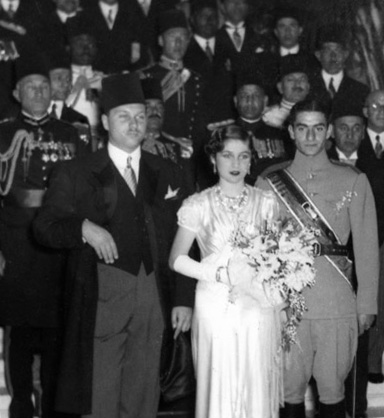
Photograph of the wedding ceremony of Crown Prince Mohammad Reza (right) and Princess Fawzia of Egypt at Abdeen Palace in Cairo, 1939
One of the main initiatives of Iranian and Turkish foreign policy had been the Saadabad pact of 1937, an alliance bringing together Turkey, Iran, Iraq, and Afghanistan, with the intent of creating a Muslim bloc that would hopefully deter any aggressors.
President Mustafa Kemal Atatürk of Turkey suggested to his friend Reza Khan during the latter's visit to Turkey that a marriage between the Iranian and Egyptian courts would be beneficial for the two countries and their dynasties, as it might lead to Egypt joining the Saadabad pact.[42] In line with this suggestion, Mohammad Reza and Princess Fawzia married. Dilawar Princess Fawzia of Egypt (5 November 1921 – 2 July 2013), a daughter of King Fuad I of Egypt and Nazli Sabri, was a sister of King Farouk I of Egypt. They married on 15 March 1939 in the Abdeen Palace in Cairo.[42] Reza Shah did not participate in the ceremony.[42] During his visit to Egypt, Mohammad Reza was greatly impressed with the grandeur of the Egyptian court as he visited the various palaces built by the Isma'il Pasha, aka "Isma'il the Magnificent", the famously free-spending Khedive of Egypt, and resolved that Iran needed palaces to match those built by Isma'il.[17]
Mohammad Reza's marriage to Fawzia produced one child, a daughter, Princess Shahnaz Pahlavi (born 27 October 1940). Their marriage was not a happy one as the Crown Prince was openly unfaithful, often being seen driving around Tehran in one of his expensive cars with one of his girlfriends.[15] Mohammad Reza's dominating and extremely possessive mother saw her daughter-in-law as a rival to her son's love, and took to humiliating Princess Fawzia, whose husband sided with his mother.[15] A quiet, shy woman, Fawzia described her marriage as miserable, feeling very much unwanted and unloved by the Pahlavi family and longing to go back to Egypt.[15] In his 1961 book Mission For My Country, Mohammad Reza wrote the "only happy light moment" of his entire marriage to Fawzia was the birth of his daughter.[17]
Deposition of his father

Pahlavi meeting with American president Franklin D. Roosevelt during the Tehran Conference (1943), two years after his father's forced abdication during the Anglo-Soviet Invasion of Iran
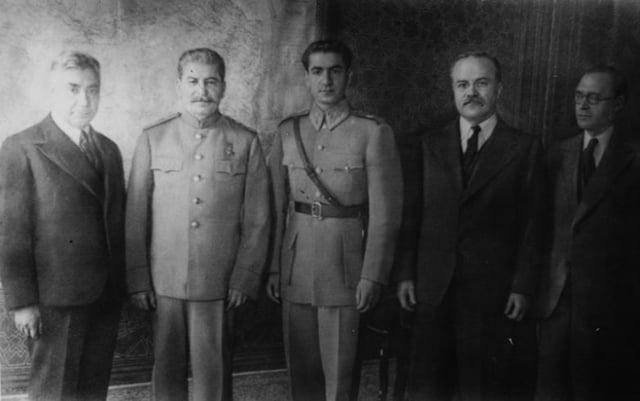
Pahlavi (centre), pictured to the right of Joseph Stalin at the Tehran Conference
In the midst of World War II in 1941, Nazi Germany began Operation Barbarossa and invaded the Soviet Union, breaking the Molotov–Ribbentrop Pact. This had a major impact on Iran, which had declared neutrality in the conflict.[46] In the summer of 1941, Soviet and British diplomats passed on numerous messages warning that they regarded the presence of a number of Germans administering the Iranian state railroads as a threat, implying war if the Germans were not dismissed.[15] Britain wished to ship arms to the Soviet Union via Iranian railroads, and statements from the German managers of the Iranian railroads that they would not cooperate made both Moscow and London insistent that the Germans Reza Khan had hired to run his railroads had to be sacked at once.[15] As his father's closest advisor, the Crown Prince Mohammad Reza did not see fit to raise the issue of a possible Anglo-Soviet invasion of Iran, blithely assuring his father that nothing would happen.[15]
The Iranian-American historian Abbas Milani wrote about the relationship between the Reza Khan and the Crown Prince: "As his father's now constant companion, the two men consulted on virtually every decision".[15] Later that year British and Soviet forces occupied Iran in a military invasion, forcing Reza Shah to abdicate.[49] On 25 August 1941, British and Australian naval forces attacked the Persian Gulf while the Soviet Union conducted a land invasion from the north. On the second day of the invasion with the Soviet air force bombing Tehran, Mohammad Reza was shocked to see the Iranian military simply collapse, with thousands of terrified officers and men all over Tehran taking off their uniforms in order to desert and run away despite the fact they had not seen combat yet.[15] Reflecting the panic, a group of senior Iranian generals called the Crown Prince to receive his blessing to hold a meeting to discuss how best to surrender.[15] When Reza Khan learned of the meeting, he flew into a rage and attacked one of his generals, Ahmad Nakhjavan, striking him with his riding crop, tearing off his medals and was about to personally execute him when his son persuaded him to have the general court-martialed instead.[15] The collapse of the Iranian military in the summer of 1941 that his father had worked so hard to build up humiliated his son, who vowed that he would never see Iran defeated like that again, which explained Mohammad Reza's later obsession with military spending.[15]
Ascension to the throne
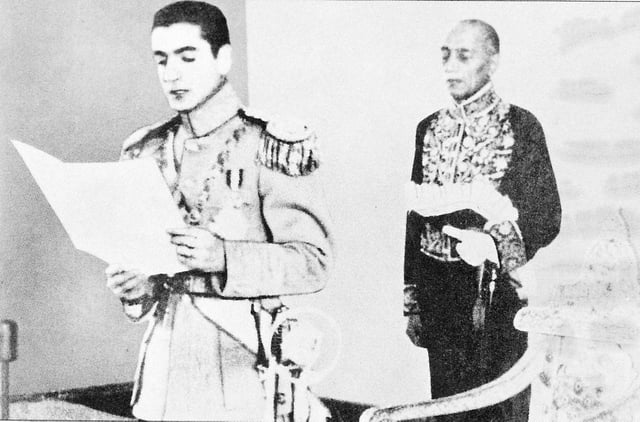
The inauguration of Mohammad Reza as Shah of Iran, 17 September 1941

Mohammad Ali Foroughi (left) with Mohammad Reza Shah
On 16 September 1941, Prime Minister Forughi and Foreign Minister Ali Soheili attended a special session of parliament to announce the resignation of Reza Shah and that Mohammad Reza was to replace him.
The next day, at 4:30 pm, Mohammad Reza took the oath of office and was received warmly by parliamentarians.
On his way back to the palace, the streets filled with people welcoming the new Shah jubilantly, seemingly more enthusiastic than the Allies would have liked.[30] The British would have liked to put a Qajar back on the throne, but the principal Qajar claimant to the throne was Prince Hamid Mirza, an officer in the Royal Navy who did not speak Persian, so the British had to accept Mohammad Reza as Shah.[17] The main Soviet interest in 1941 was to ensure political stability to ensure Allied supplies, which meant accepting the throne. Subsequent to his succession as king, Iran became a major conduit for British and, later, American aid to the USSR during the war. This massive supply effort became known as the Persian Corridor.[53]
Much of the credit for orchestrating a smooth transition of power from the King to the Crown Prince was due to the efforts of Mohammad Ali Foroughi.[54] Suffering from angina, a frail Foroughi was summoned to the Palace and appointed prime minister when Reza Shah feared the end of the Pahlavi dynasty once the Allies invaded Iran in 1941.[55] When Reza Shah sought his assistance to ensure that the Allies would not put an end to the Pahlavi dynasty, Foroughi put aside his adverse personal sentiments for having been politically sidelined since 1935. The Crown Prince confided in amazement to the British Minister that Foroughi "hardly expected any son of Reza Shah to be a civilized human being",[55] but Foroughi successfully derailed thoughts by the Allies to undertake a more drastic change in the political infrastructure of Iran.[56]
A general amnesty was issued two days after Mohammad Reza's accession to the throne on 19 September 1941.
All political personalities who had suffered disgrace during his father's reign were rehabilitated, and the forced unveiling policy inaugurated by his father in 1935 was overturned.
Despite the young king's enlightened decisions, the British Minister in Tehran reported to London that "the young Shah received a fairly spontaneous welcome on his first public experience, possibly rather [due] to relief at the disappearance of his father than to public affection for himself".
During his early days as Shah, Mohammad Reza lacked self-confidence and spent most of his time with Perron writing poetry in French.[15]
In 1942, Mohammad Reza met Wendell Willkie, the Republican candidate for the U.S. presidency in the 1940 election who was now on a world tour for President Roosevelt to promote his "one world" policy; Willkie took him flying for the first time.[17] The prime minister Ahmad Qavam had advised the Shah against flying with Wilkie, saying he had never met a man with a worse flatulence problem, but the Shah took his chances.[17] Mohammed Reza told Willkie that when he was flying he "wanted to stay up indefinitely".[17] Enjoying flight, Mohammad Reza hired the American pilot Dick Collbarn to teach him how to fly. Upon arriving at the Marble Palace, Collbarn noted that "the Shah must have twenty-five custom-built cars...Buicks, Cadillacs, six Rolls-Royces, a Mercedes".[17] During the Tehran conference in 1943, the Shah was humiliated when he met Joseph Stalin, who visited him in the Marble Palace and did not allow the Shah's bodyguards to be present, with the Red Army alone guarding the Marble Palace during Stalin's visit.[15]
Opinion of his father's rule
Despite his public professions of admiration in later years, Mohammad Reza had serious misgivings about not only the coarse and roughshod political means adopted by his father, but also his unsophisticated approach to affairs of state.
The young Shah possessed a decidedly more refined temperament, and amongst the unsavory developments that "would haunt him when he was king" were the political disgrace brought by his father on Teymourtash; the dismissal of Foroughi by the mid-1930s; and Ali Akbar Davar's suicide in 1937.[61] An even more significant decision that cast a long shadow was the disastrous and one-sided agreement his father had negotiated with the Anglo-Persian Oil Company (APOC) in 1933, one which compromised the country's ability to receive more favourable returns from oil extracted from the country.
Relationship with his exiled father
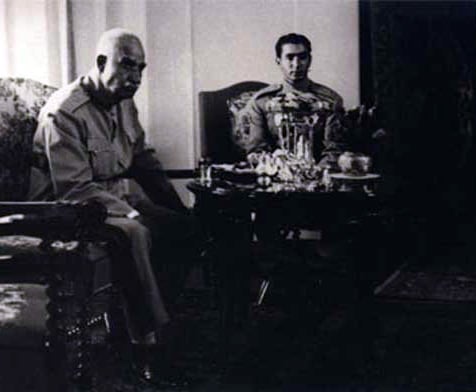
Crown Prince Mohammad Reza with his father, Reza Shah, September 1941
Mohammad Reza expressed concern for his exiled father who had previously complained to the British governor of Mauritius that living on the island was both a climatic and social prison.
Attentively following his life in exile, Mohammad Reza would object to his father's treatment to British at any opportunity.
The two sent letters to one another, although delivery was often delayed, and Mohammad Reza commissioned his friend, Ernest Perron, to hand-deliver a taped message of love and respect to his father, bringing back with him a recording of his voice.[30]
My dear son, since the time I resigned in your favour and left my country, my only pleasure has been to witness your sincere service to your country.
I have always known that your youth and your love of the country are vast reservoirs of power on which you will draw to stand firm against the difficulties you face and that, despite all the troubles, you will emerge from this ordeal with honour.
Not a moment passes without my thinking of you and yet the only thing that keeps me happy and satisfied is the thought that you are spending your time in the service of Iran.
You must remain always aware of what goes on in the country.
You must not succumb to advice that is self-serving and false.
You must remain firm and constant.
You must never be afraid of the events that come your way.
Now that you have taken on your shoulders this heavy burden in such dark days, you must know that the price to be paid for the slightest mistake on your part may be our twenty years of service and our family's name.
You must never yield to anxiety or despair; rather, you must remain calm and so strongly rooted in your place that no power may hope to move the constancy of your will.[30]
The young Shah

Picture of Mohammad Reza in hospital after the failed assassination attempt, 1949

Mohammad Reza after the assassination attempt; for a year afterwards he used a mustache to hide the scar caused by the bullet.
In 1945–46, the main issue in Iranian politics were the Soviet-sponsored separatist government in Iranian Azerbaijan and Kurdistan, which greatly alarmed the Shah.
He repeatedly clashed with his prime minister Ahmad Qavam, whom he viewed as too pro-Soviet.[15] At the same time, the growing popularity of the Tudeh Party also worried Mohammad Reza, who felt there was a serious possibility of a coup by the Tudeh.[15] In June 1946, Mohammad Reza was relieved when the Red Army pulled out of Iran.[15] In a letter to the Azerbaijani Communist leader Ja'far Pishevari, Stalin stated that he had to pull out of Iran as otherwise the Americans would not pull out of China, and he wanted to assist the Chinese Communists in their civil war against the Kuomintang.[15] However, the Pishevari regime remained in power in Tabriz, and Mohammad Reza sought to undercut Qavam's attempts to make an agreement with Pishevari as way of getting rid of both.[15] On 11 December 1946, the Iranian Army led by the Shah in person entered Iranian Azerbaijan and the Pishevari regime collapsed with little resistance, with most of the fighting occurring between ordinary people who attacked functionaries of the Pishevari regime who had behaved brutally.[15] In his statements at the time and later, Mohammad Reza credited his easy success in Azerbaijan to his "mystical power".[15] Knowing Qavam's penchant for corruption, the Shah used that issue as a reason to sack him.[15] By this time, Fawzia had returned to Egypt, and despite efforts to have King Farouk persuade her to return to Iran she refused to go, which led Mohammad Reza to divorce her on 17 November 1947.[17]
A qualified pilot, Mohammad Reza was fascinated with flying and the technical details of aeroplanes, and any insult to him was always an attempt to "clip my wings".
Mohammad Reza directed more money to the Imperial Iranian Air Force than any branch of the armed forces, and his favourite uniform was that of the Marshal of the Imperial Iranian Air Force.[23] Zonis wrote that Mohammad Reza's obsession with flying reflected an Icarus complex, also known as "ascensionism", a form of narcissism based on "a craving for unsolicited attention and admiration" and the "wish to overcome gravity, to stand erect, to grow tall... to leap or swing into the air, to climb, to rise, to fly...".[23]
Besides an obsession with transcending gravity by flying, men with an Icarus complex tend to see women merely as sexual objects, which fitted in with Mohammad Reza, who was well known as a womaniser who often spoke of women as sexual objects who existed only to gratify him, which led to his celebrated 1973 exchange with Fallaci, who vehemently objected to his attitudes towards women.[23] As a regular visitor to the nightclubs of Italy, France and the United Kingdom, Mohammad Reza was linked romantically to several actresses including Gene Tierney, Yvonne De Carlo and Silvana Mangano.[7]
The young Shah was also the target of at least two unsuccessful assassination attempts.
On 4 February 1949, he attended an annual ceremony to commemorate the founding of Tehran University.[77] At the ceremony, Fakhr-Arai fired five shots at him at a range of c. three metres. Only one of the shots hit the king, grazing his cheek. Fakhr-Arai was instantly shot by nearby officers. After an investigation, it was thought that Fakhr-Arai was a member of the Tudeh Party,[78] which was subsequently banned.[3] However, there is evidence that the would-be assassin was not a Tudeh member but a religious fundamentalist member of Fada'iyan-e Islam.[7][80] The Tudeh were nonetheless blamed and persecuted.[81]
The Shah's second wife was Soraya Esfandiary-Bakhtiari, a half-German half-Iranian woman and the only daughter of Khalil Esfandiary, Iranian Ambassador to West Germany, and his wife, the former Eva Karl. She was introduced to the Shah by Forough Zafar Bakhtiary, a close relative of Soraya's, via a photograph taken by Goodarz Bakhtiary, in London, per Forough Zafar's request. They married on 12 February 1951,[42] when Soraya was 18 according to the official announcement; however, it was rumoured that she was actually 16, the Shah being 32.[82] As a child she was tutored and brought up by Frau Mantel, and hence lacked proper knowledge of Iran, as she herself admits in her personal memoirs, stating, "I was a dunce—I knew next to nothing of the geography, the legends of my country, nothing of its history, nothing of Muslim religion."[83]
Oil nationalisation and the 1953 coup
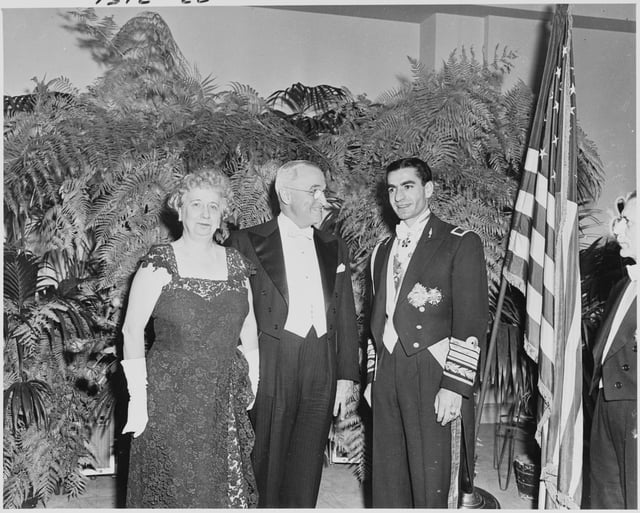
Pahlavi with US President Truman in Washington, November 1949

The Shah speaking with Prime Minister Mohammad Mosaddegh, 1951
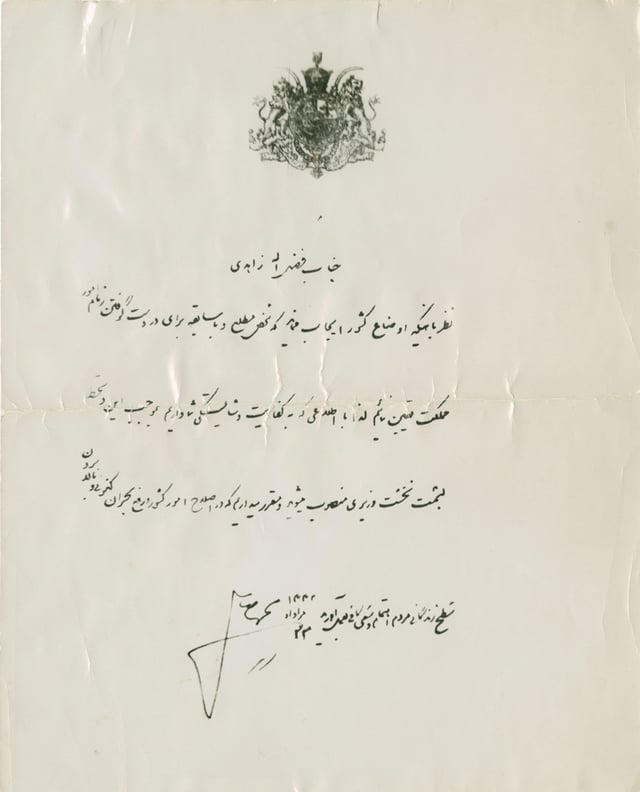
The Shah's firman naming General Fazlollah Zahedi the new prime minister. Coup operatives made copies of the document and circulated it around Tehran to help regenerate momentum following the collapse of the original plan.
By the early 1950s, the political crisis brewing in Iran commanded the attention of British and American policy leaders.
In 1951, Mohammad Mosaddegh was appointed prime minister. He was committed to nationalising the Iranian petroleum industry controlled by the Anglo-Iranian Oil Company (AIOC) (as Anglo-Persian Oil Company or APOC had become).[84] Under the leadership of Mosaddegh and his nationalist movement, the Iranian parliament unanimously voted to nationalise the oil industry—thus shutting out the immensely profitable AIOC, which was a pillar of Britain's economy and provided it political clout in the region.[85]
At the start of the confrontation, American political sympathy was forthcoming from the Truman Administration.[86] In particular, Mosaddegh was buoyed by the advice and counsel he was receiving from the American Ambassador in Tehran, Henry F. Grady. However, eventually American decision-makers lost their patience, and by the time the Republican administration of President Dwight D. Eisenhower entered office, fears that communists were poised to overthrow the government became an all-consuming concern; these concerns were later dismissed as "paranoid" in retrospective commentary on the coup from US government officials. Shortly prior to the 1952 presidential election in the United States, the British government invited CIA officer Kermit Roosevelt Jr., to London to propose collaboration on a secret plan to force Mosaddegh from office.[87] This would be the first of three "regime change" operations led by Allen Dulles (the other two being the successful CIA-instigated 1954 Guatemalan coup d'état and the failed Bay of Pigs Invasion of Cuba).
Under the direction of Kermit Roosevelt Jr., a senior Central Intelligence Agency (CIA) officer and grandson of former US President Theodore Roosevelt, the American CIA and British Secret Intelligence Service (SIS) funded and led a covert operation to depose Mosaddegh with the help of military forces disloyal to the government. Referred to as Operation Ajax,[88] the plot hinged on orders signed by Mohammad Reza to dismiss Mosaddegh as prime minister and replace him with General Fazlollah Zahedi, a choice agreed on by the British and Americans.[89][90][91][92]
Despite the high-level coordination and planning, the coup initially failed, causing the Shah to flee to Baghdad, and then to Rome. During his time in Rome, a British diplomat reported about a monarch who spent most of his time in nightclubs with Queen Soraya or his latest mistress: "He hates taking decisions and cannot be relied on to stick to them when taken. He has no moral courage and succumbs easily to fear".[7] To get him to support the coup, his twin sister Princess Ashraf, who was much tougher than him and publicly questioned his manhood several times, visited him on 29 July 1953 to berate him into signing a decree dismissing Mossaddegh.[7] After a brief exile in Italy, he returned to Iran, this time through a successful second attempt at a coup. A deposed Mosaddegh was arrested and tried. The king intervened and commuted the sentence to three years,[95] to be followed by life in internal exile. Zahedi was installed to succeed Mosaddegh.[96]
Before the first attempted coup, the American Embassy in Tehran reported that Mosaddegh's popular support remained robust.
The Prime Minister requested direct control of the army from the Majlis. Given the situation, alongside the strong personal support of Conservative Prime Minister Winston Churchill and Foreign Secretary Anthony Eden for covert action, the American government gave the go-ahead to a committee, attended by the Secretary of State John Foster Dulles, Director of Central Intelligence Allen Dulles, Kermit Roosevelt, Henderson, and Secretary of Defense Charles Erwin Wilson. Kermit Roosevelt returned to Iran on 13 July 1953, and again on 1 August 1953, in his first meeting with the king. A car picked him up at midnight and drove him to the palace. He lay down on the seat and covered himself with a blanket as guards waved his driver through the gates. The Shah got into the car and Roosevelt explained the mission. The CIA bribed him with $1 million in Iranian currency, which Roosevelt had stored in a large safe – a bulky cache, given the then exchange rate of 1,000 rial to 15 dollars.[97]
The Communists staged massive demonstrations to hijack Mosaddegh's initiatives, and the United States actively plotted against him.
On 16 August 1953, the right wing of the Army attacked.
Armed with an order by the Shah, it appointed General Fazlollah Zahedi as prime minister. A coalition of mobs and retired officers close to the Palace executed this coup d'état. They failed dismally and the Shah decided to leave the country. Ettelaat, the nation's largest daily newspaper, and its pro-Shah publisher, Abbas Masudi, were against him, calling the defeat "humiliating".[98]
During the following two days, the Communists turned against Mosaddegh.
Opposition against him grew tremendously.
They roamed Tehran, raising red flags and pulling down statues of Reza Shah.
This was rejected by conservative clerics like Kashani and National Front leaders like Hossein Makki, who sided with the king. On 18 August 1953, Mosaddegh defended the government against this new attack. Tudeh partisans were clubbed and dispersed.[99]
The Tudeh party had no choice but to accept defeat.
In the meantime, according to the CIA plot, Zahedi appealed to the military, claimed to be the legitimate prime minister and charged Mosaddegh with staging a coup by ignoring the Shah's decree.
Zahedi's son Ardeshir acted as the contact between the CIA and his father.
On 19 August 1953, pro-Shah partisans – bribed with $100,000 in CIA funds – finally appeared and marched out of south Tehran into the city centre, where others joined in.
Gangs with clubs, knives, and rocks controlled the streets, overturning Tudeh trucks and beating up anti-Shah activists.
As Roosevelt was congratulating Zahedi in the basement of his hiding place, the new Prime Minister's mobs burst in and carried him upstairs on their shoulders.
That evening, Henderson suggested to Ardashir that Mosaddegh not be harmed.
Roosevelt gave Zahedi US$900,000 left from Operation Ajax funds.[100]
US actions further solidified sentiments that the West was a meddlesome influence in Iranian politics.
In the year 2000, reflecting on this notion, US Secretary of State Madeleine K. Albright stated:
In 1953 the United States played a significant role in orchestrating the overthrow of Iran's popular prime minister, Mohammad Mosaddegh.
The Eisenhower Administration believed its actions were justified for strategic reasons; but the coup was clearly a setback for Iran's political development.
And it is easy to see now why many Iranians continue to resent this intervention by America in their internal affairs.[101]
Mohammad Reza returned to power, but never extended the elite status of the court to the technocrats and intellectuals who emerged from Iranian and Western universities.
Indeed, his system irritated the new classes, for they were barred from partaking in real power.[102]
The Shah asserts himself: from playboy to progressive
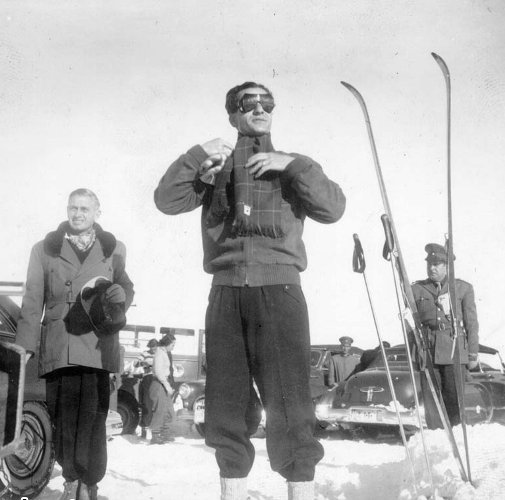
Mohammad Reza with his friend and advisor, Ernest Perron (left), 1950s
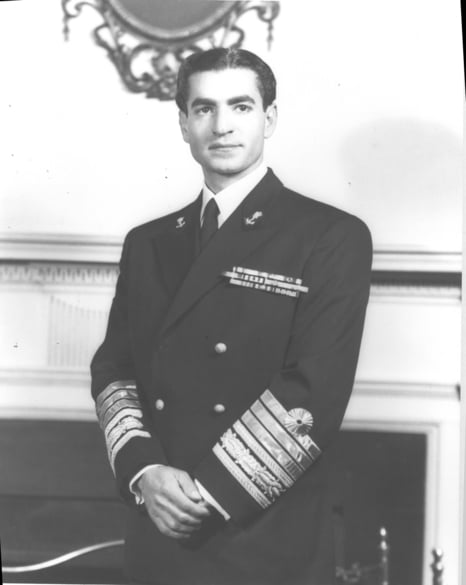
Formal portrait of the young Shah in full military dress, c. 1949
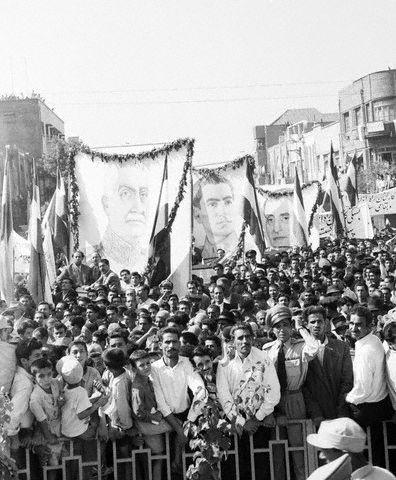
Pro Shah demonstration, 1954

Universal Newsreel

The Shah lighting a cigarette for his wife Soraya, 1950s
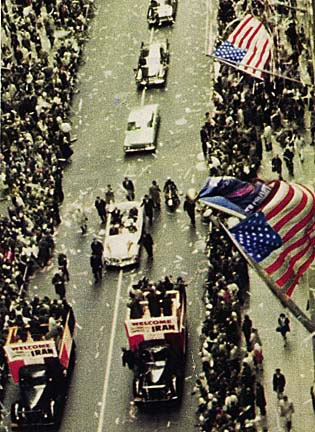
The Shah visiting New York, 1960s
In the aftermath of the 1953 coup d'état, Mohammad Reza was widely viewed as a figurehead monarch, and General Fazlollah Zahedi, the Prime Minister, saw himself and was viewed by others as the "strong man" of Iran.[103] Mohammad Reza feared that history would repeat itself, remembering how his father was a general who had seized power in a coup d'état in 1921 and deposed the last Qajar shah in 1925, and his major concern in the years 1953–55 was to neutralise Zahedi.[103] American and British diplomats in their reports back to Washington and London in the 1950s were openly contemptuous of Mohammad Reza's ability to lead, calling the Shah a weak-willed and cowardly man who was incapable of making a decision.[103] The contempt in which the Shah was held by Iranian elites led to a period in the mid 1950s where the elite displayed fissiparous tendencies, feuding amongst themselves now that Mossadegh had been overthrown, which ultimately allowed Mohammad Reza to play off various factions in the elite to assert himself as the nation's leader.[103]
The very fact that Mohammad Reza was considered a coward and something of an airhead turned out be an advantage as the Shah proved to be an adroit politician, playing off the factions in the elite and the Americans against the British with the aim of being an autocrat in practice as well in theory.[103] Supporters of the banned National Front were persecuted, but in his first important decision as leader, Mohammad Reza intervened to ensure most of the members of the National Front brought to trial, such as Mosaddegh himself, were not executed as many had expected.[103] Many in the Iranian elite were openly disappointed that Mohammad Reza did not conduct the expected bloody purge and hang Mosaddegh and his followers as they had wanted and expected.[103] In 1954, when twelve university professors issued a public statement criticising the 1953 coup, all were dismissed from their jobs, but in the first of his many acts of "magnanimity" towards the National Front, Mohammad Reza intervened to have them reinstated.[103] Mohammad Reza tried very hard to co-opt the supporters of the National Front by adopting some of their rhetoric and addressing their concerns, for example declaring in several speeches his concerns about the Third World economic conditions and poverty which prevailed in Iran, a matter that had not much interested him before.[103]
Mohammad Reza was determined to copy Mosaddegh, who had won popularity by promising broad socio-economic reforms, and wanted to create a mass powerbase as he did not wish to depend upon the traditional elites, who only wanted him as a legitimising figurehead.[103] In 1955, Mohammad Reza dismissed General Zahedi from his position as prime minister and appointed his archenemy, the technocrat Hossein Ala' as prime minister, whom he in turn dismissed in 1957.[103] Starting in 1955, Mohammad Reza began to quietly cultivate left-wing intellectuals, many of whom had supported the National Front and some of whom were associated with the banned Tudeh party, asking them for advice about how best to reform Iran.[103] It was during this period that Mohammad Reza began to embrace the image of a "progressive" Shah, a reformer who would modernise Iran, who attacked in his speeches the "reactionary" and "feudal" social system that was retarding progress, bring about land reform and give women equal rights.[103]
Determined to rule as well as reign, it was during the mid 1950s that Mohammad Reza started to promote a state cult around Cyrus the Great, portrayed as a great Shah who had reformed the country and built an empire with obvious parallels to himself.[103] Alongside this change in image, Mohammad Reza started to speak of his desire to "save" Iran, a duty that he claimed he had been given by God, and promised that under his leadership Iran would reach a Western standard of living in the near future.[103] During this period, Mohammad Reza sought the support of the ulema, and resumed the traditional policy of persecuting those Iranians who belonged to the Baha'i faith, allowing the chief Baha'i temple in Tehran to be razed in 1955 and bringing in a law banning the Baha'i from gathering together in groups.[103] A British diplomat reported in 1954 that Reza Khan "... must have been spinning in his grave at Rey. To see the arrogance and effrontery of the mullahs once again rampant in the holy city! How the old tyrant must despise the weakness of his son, who allowed these turbulent priests to regain so much of their reactionary influence!"[103] By this time, the Shah's marriage was under strain as Queen Soraya complained about the power of Mohammad Reza's best friend Ernest Perron, whom she called a "shetun" (an insulting Persian term that translates roughly as a "piece of shit") and a "limping devil".[17] Perron was a man much resented for his influence on Mohammad Reza and was often described by enemies as a "diabolical" and "mysterious" character, whose position was that of a private secretary, but who was one of the Shah's closest advisors, holding far more power than his job title suggested.[17]
In a 1957 study done by the State Department, Mohammad Reza was praised for his "growing maturity" and no longer needing "to seek advice at every turn" as the previous 1951 study had concluded.[17] On 27 February 1958, a military coup to depose the Shah led by General Valiollah Gharani was thwarted, which led to a major crisis in Iranian-American relations when evidence emerged that associates of Gharani had met American diplomats in Athens, which the Shah used to demand that henceforward no American officials could meet with his opponents.[17] Another issue in Iranian-American relations was Mohammad Reza's suspicion that the United States was insufficiently committed to Iran's defence, noting that the Americans refused to join the Baghdad Pact, and military studies had indicated that Iran could only hold out for a few days in the event of a Soviet invasion.[17]
In January 1959, the Shah began negotiations on a non-aggression pact with the Soviet Union, which he claimed to have been driven to by a lack of American support.[17] After receiving a mildly threatening letter from President Eisenhower warning him against signing the treaty, Mohammad Reza chose not to sign, which led to a major Soviet propaganda effort calling for his overthrow.[17] Soviet leader Nikita Khrushchev ordered Mohammad Reza assassinated.[17] A sign of Mohammad Reza's power came in 1959 when a British company won a contract with the Iranian government that was suddenly cancelled and given to Siemens instead.[17] An investigation by the British embassy soon uncovered the reason why: Mohammad Reza wanted to bed the wife of the Siemens sales agent for Iran, and the Siemens agent had consented to allowing his wife to sleep with the Shah in exchange for winning back the contract that he had just lost.[17] On 24 July 1959, Mohammad Reza gave Israel de facto recognition by allowing an Israeli trade office to be opened in Tehran that functioned as a de facto embassy, a move that offended many in the Islamic world.[17] When Eisenhower visited Iran on 14 December 1959, Mohammad Reza told him that Iran faced two main external threats: the Soviet Union to the north and the new pro-Soviet revolutionary government in Iraq to the west. This led him to ask for vastly increased American military aid, saying his country was a front-line state in the Cold War that needed as much military power as possible.[17]
The Shah and Soraya's controversial marriage ended in 1958 when it became apparent that, even with help from medical doctors, she could not bear children.
Soraya later told the New York Times that the Shah had no choice but to divorce her, and that he was heavy-hearted about the decision.[123] However, even after the marriage, it is reported that the Shah still had great love for Soraya, and it is reported that they met several times after their divorce and that she lived her post-divorce life comfortably as a wealthy lady, even though she never remarried;[124] being paid a monthly salary of about $7,000 from Iran.[125] Following her death in 2001 at the age of 69 in Paris, an auction of the possessions included a three-million-dollar Paris estate, a 22.37 carat diamond ring and a 1958 Rolls-Royce.[126]
Pahlavi subsequently indicated his interest in marrying Princess Maria Gabriella of Savoy, a daughter of the deposed Italian king, Umberto II. Pope John XXIII reportedly vetoed the suggestion. In an editorial about the rumours surrounding the marriage of a "Muslim sovereign and a Catholic princess", the Vatican newspaper, L'Osservatore Romano, considered the match "a grave danger",[127] especially considering that under the 1917 Code of Canon Law a Roman Catholic who married a divorced person would be automatically, and could be formally, excommunicated.
In the 1960 U.S. presidential election, the Shah had favoured the Republican candidate, incumbent Vice President Richard Nixon, whom he had first met in 1953 and rather liked, and according to the diary of his best friend Asadollah Alam, Mohammad Reza contributed money to the 1960 Nixon campaign.[17] Relations with the victor of the 1960 election, the Democrat John F. Kennedy, were not friendly.[17] In an attempt to mend relations after Nixon's defeat, Mohammad Reza sent General Teymur Bakhtiar of SAVAK to meet Kennedy in Washington on 1 March 1961.[17] From Kermit Roosevelt, Mohammad Reza learned that Bakhtiar, during his trip to Washington, had asked the Americans to support a coup he was planning, which greatly increased the Shah's fears about Kennedy.[17] On 2 May 1961, a teacher's strike involving 50, 000 people began in Iran, which Mohammad Reza believed was the work of the CIA.[17] Mohammad Reza had to sack his prime minister Jafar Sharif-Emami and give in to the teachers after learning that the Army probably would not fire on the demonstrators.[17] In 1961, Bakhtiar was dismissed as chief of SAVAK and expelled from Iran in 1962 following a clash between demonstrating university students and the army on 21 January 1962 that left three dead.[17] In April 1962, when Mohammad Reza visited Washington, he was met with demonstrations by Iranian students at American universities, which he believed were organised by U.S. Attorney General Robert F. Kennedy, the President's brother and the leading anti-Pahlavi voice in the Kennedy administration.[17] Afterwards, Mohammad Reza visited London. In a sign of the changed dynamics in Anglo-Iranian relations, the Shah took offence when he was informed he could join Queen Elizabeth II for a dinner at Buckingham Palace that was given in somebody else's honour, insisting successfully he would have dinner with the Queen only when given in his own honour.[17]
Mohammad Reza's first major clash with Ayatollah Khomeini took place in 1962, when the Shah changed the local laws to allow Iranian Jews, Christians, Zoroastrians, and Baha'i to take the oath of office for municipal councils using their holy books instead of the Koran.[17] Khomeini wrote to the Shah to say this was unacceptable and that only the Koran could be used to swear in members of the municipal councils regardless of what their religion was, writing that he heard "Islam is not indicated as a precondition for standing for office and women are being granted the right to vote...Please order all laws inimical to the sacred and official faith of the country to be eliminated from government policies."[17] The Shah wrote back, addressing Khomeini as Hojat-al Islam rather than as Ayatollah, declining his request.[17] Feeling pressure from demonstrations organised by the clergy, the Shah withdraw the offending law, but it was reinstated with the White Revolution of 1963.[17]
Middle years
The Shah and his enemies
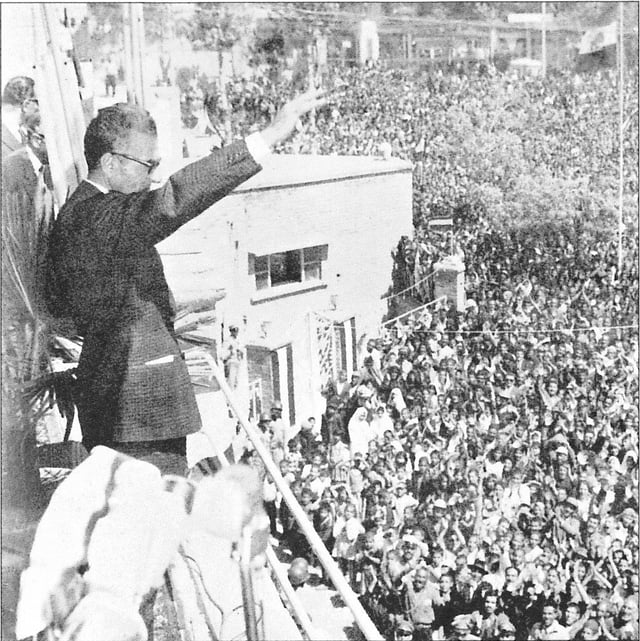
The Shah speaks about the principles of his White Revolution, 1963
In 1963, Mohammad Reza launched the White Revolution, a series of far-reaching reforms, which caused much opposition from the religious scholars. They were enraged that the referendum approving of the White Revolution in 1963 allowed women to vote, with the Ayatollah Khomeini saying in his sermons that the fate of Iran should never be allowed to be decided by women.[17] In 1963 and 1964, nationwide demonstrations against Mohammad Reza's rule took place all over Iran, with the centre of the unrest being the holy city of Qom.[139]The%20Fighting%20Never%20Stopped%3A%20a%20co]]Students studying to be imams at Qom were most active in the protests, and Ayatollah Khomeini emerged as one of the leaders, giving sermons calling for the Shah's overthrow.[[139]](https://openlibrary.org/search?q=Brogan%2C%20Patrick.%20 [[CITE|139|https://openlibrary.org/search?q=Brogan%2C%20Patrick.%20*The%20Fighting%20Never%20Stopped%3A%20a%20co) homeini was exiled to Iraq in August 1964.[139]
According to Vladimir Kuzichkin – a former KGB officer who defected to the SIS – the Soviet Union also allegedly targeted the Shah. The Soviets tried to use a TV remote control to detonate a bomb-laden Volkswagen Beetle; the TV remote failed to function.[143] A high-ranking Romanian defector, Ion Mihai Pacepa, also supported this claim, asserting that he had been the target of various assassination attempts by Soviet agents for many years.
The Shah and his court
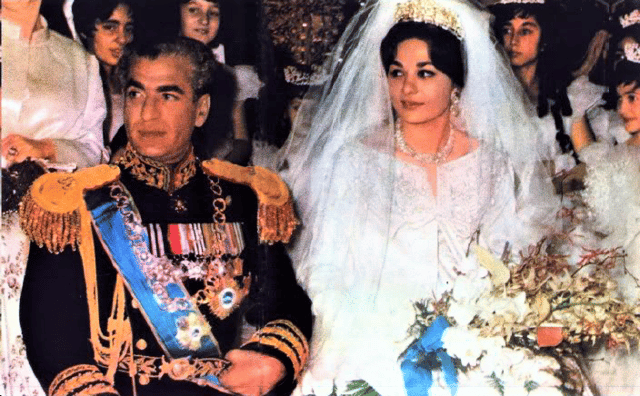
Wedding of the Shah with Farah Diba on 20 December 1959
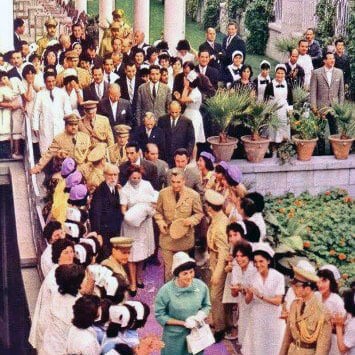
The Shah and his wife, Farah, after the birth of their son, Reza, in a public hospital in Tehran
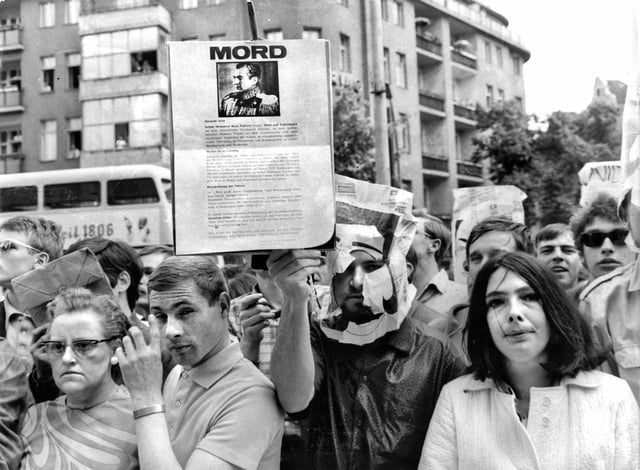
An anti-Shah demonstration in Germany, 1968
Mohammad Reza 's third and final wife was Farah Diba (born 14 October 1938), the only child of Sohrab Diba, a captain in the Imperial Iranian Army (son of an Iranian ambassador to the Romanov Court in St. Petersburg, Russia), and his wife, the former Farideh Ghotbi. They were married in 1959, and Queen Farah was crowned Shahbanu, or Empress, a title created specially for her in 1967. Previous royal consorts had been known as "Malakeh" (Arabic: Malika), or Queen. The couple remained together for twenty one years, until the Shah's death. They had four children together:
Crown Prince Reza Pahlavi (born 31 October 1960), heir to the now defunct Iranian throne. Reza Pahlavi is the founder and leader of National Council of Iran, a government in exile of Iran;
Princess Farahnaz Pahlavi (born 12 March 1963);
Prince Ali-Reza Pahlavi (28 April 1966 – 4 January 2011);
Princess Leila Pahlavi (27 March 1970 – 10 June 2001).
One of Mohammad Reza's favourite activities was watching films and his favourites were light French comedies and Hollywood action films, much to the disappointment of Farah who tried hard to interest him in more serious films.[17] Mohammad Reza was frequently unfaithful towards Farah, and his right-hand man Asadollah Alam regularly imported tall European women for "outings" with the Shah, though Alam's diary also mentions that if women from the "blue-eyed world" were not available, he would bring the Shah "local product".[17] Mohammad Reza had an insatiable appetite for sex, and Alam's diary has the Shah constantly telling him he needed to have sex several times a day, every day, or otherwise he would fall into depression.[17] When Farah found out about his affairs in 1973, Alam blamed the prime minister Amir Abbas Hoveyda while the Shah thought it was the KGB, and Milani noted neither admitted it was the Shah's "crass infidelities" that caused this issue.[17] Milani further wrote that "Alam, in his most destructive moments of sycophancy, reassured the Shah – or his "master" as he calls him – that country was prosperous and no one begrudged the King a bit of fun". He also had a passion for automobiles and aeroplanes, and by the middle 1970s, the Shah had amassed one of the world's largest collection of luxury cars and planes.[15] His visits to the West were invariably the occasions for major protests by the Confederation of Iranian Students, an umbrella group of left-wing Iranian university students studying abroad, and Mohammad Reza had one of the world's largest security details as he lived in constant fear of assassination.[15]
Milani described Mohammad Reza's court as open and tolerant, noting that his and Farah's two favourite interior designers, Keyvan Khosravani and Bijan Saffari, were openly gay, and were not penalised for their sexual orientation with Khosravani often giving advice to the Shah about how to dress.[17] Milani noted the close connection between architecture and power in Iran as architecture is the "poetry of power" in Iran.[17] In this sense, the Niavaran Palace, with its mixture of modernist style, heavily influenced by current French styles and traditional Persian style, reflected Mohammad Reza's personality.[17] Mohammad Reza was a Francophile whose court had a decidedly French ambiance to it.[17] However, when he commissioned a documentary from the French film-maker Albert Lamorisse meant to glorify Iran under his rule, he was annoyed that Lamorisse focused only on Iran's past, writing to Lamorisse there was no modern buildings in his film, which he charged made Iran look "backward".[17] Mohammad Reza's office was functional whose ceilings and walls were decorated with Qajar art.[17] Farah began collecting art and by the early 1970s owned works by Picasso, Gauguin, Chagall, and Braque, which added to the modernist feel of the Niavaran Palace[17]
Imperial coronation

Shah Mohammad Reza with his consort and crown prince after the coronation, 1967
On 26 October 1967, twenty-six years into his reign as Shah ("King"), he took the ancient title Shāhanshāh ("Emperor" or "King of Kings") in a lavish coronation ceremony held in Tehran. He said that he chose to wait until this moment to assume the title because in his own opinion he "did not deserve it" up until then; he is also recorded as saying that there was "no honour in being Emperor of a poor country" (which he viewed Iran as being until that time).[153]
2,500-year celebrations

The arrival of Shah Mohammad Reza, Shahbanu Farah and Crown Prince Reza in Pasargadae, in front of Cyrus' tomb, 12 October 1971
As part of his efforts to modernise Iran and give the Iranian people a non-Islamic identity, Mohammad Reza quite consciously started to celebrate Iranian history before the Arab conquest with a special focus on the Achaemenid period.[154] At the celebration at Persepolis in 1971, the Shah had an elaborate fireworks show put on together with a sound and light show transmitted by hundreds of hidden loudspeakers and projectors intended to send a dual message; that Iran was still faithful to its ancient traditions and that Iran had transcended its past to become a modern nation, that Iran was not "stuck in the past", but as a nation that embraced modernity had chosen to be faithful to its past.[155] The message was further reinforced the next day when the "Parade of Persian History" was performed at Persepolis when 6,000 soldiers dressed in the uniforms of every dynasty from the Achaemenids to the Pahlavis marched past Mohammad Reza in a grand parade that many contemporaries remarked "surpassed in sheer spectacle the most florid celluloid imaginations of Hollywood epics".[155] To complete the message, Mohammad Reza finished off the celebrations by opening a brand new museum in Tehran, the Shahyad Aryamehr, that was housed in a very modernistic building and attended another parade in the newly opened Aryamehr Stadium, intended to give a message of "compressed time" between antiquity and modernity.[155] A brochure put up by the Celebration Committee explicitly stated the message: "Only when change is extremely rapid, and the past ten years have proved to be so, does the past attain new and unsuspected values worth cultivating", going on to say the celebrations were held because "Iran has began to feel confident of its modernization".[155] Milani noted it was sign of the liberalization of the middle years of Mohammad Reza's reign that Hussein Amanat, the architect who designed the Shahyad was a young Baha'i from a middle-class family who did not belong to the "thousand families" that traditionally dominated Iran, writing that it only in this moment in Iranian history that this was possible.[17]
Economy
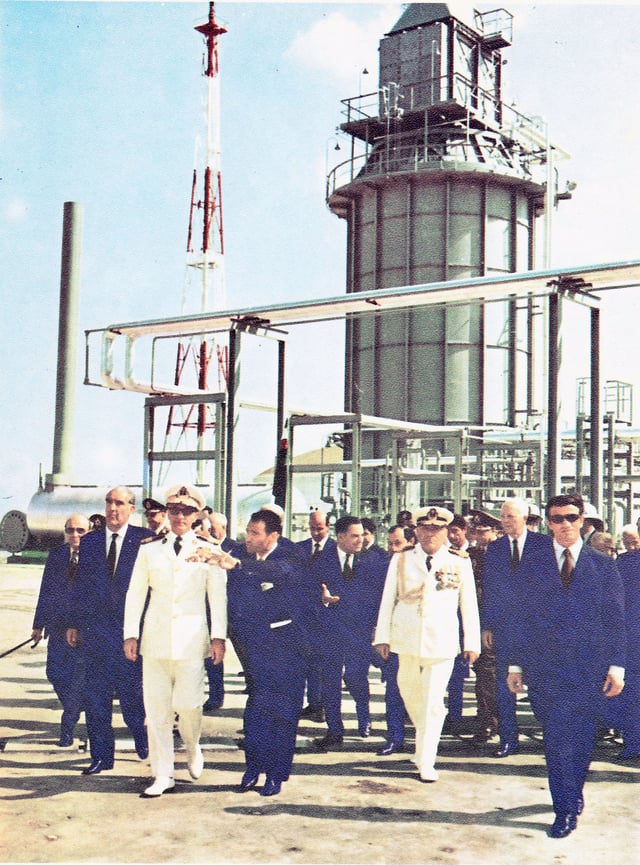
The Shah visiting the Kharg Petrochemical Complex, 1970
In the 1970s, Iran had an economic growth rate equal to that of South Korea, Turkey and Taiwan, and Western journalists all regularly predicated that Iran would become a First World nation within the next generation.[17] Significantly, a "reverse brain drain" had begun with Iranians who had been educated in the West returning home to take up positions in government and business.[17] The firm of Iran National ran by the Khayami brothers had become by 1978 the largest automobile manufacturer in the Middle East producing 136,000 cars every year while employing 12,000 people in Meshed.[17] One of the Khayami brothers complained if had not been for the revolution "Iran National would be where the South Korean car industry is today". Mohammad Reza had strong etatist tendencies and was deeply involved in the economy with his economic policies bearing a strong resemblance to the same etatist policies being pursued by General Park Chung-hee in South Korea at the same time. Mohammad Reza considered himself to be a socialist, saying he was "more socialist and revolutionary than anyone".[17] Reflecting his self-proclaimed socialist tendencies, though unions were illegal, but the Shah brought in labour laws that were "surprising fair to workers".[17] Iran in the 1960s and 70s was a tolerant place for the Jewish minority with one Iranian Jew, David Menasheri, remembering that Mohammad Reza's reign was the "golden age" for Iranian Jews when they were equals, and when the Iranian Jewish community was one of the wealthiest Jewish communities in the world. The Baha'i minority also did well after the bout of persecution in the mid-1950s ended with several Baha'i families becoming prominent in world of Iranian business.[17]
Foreign relations
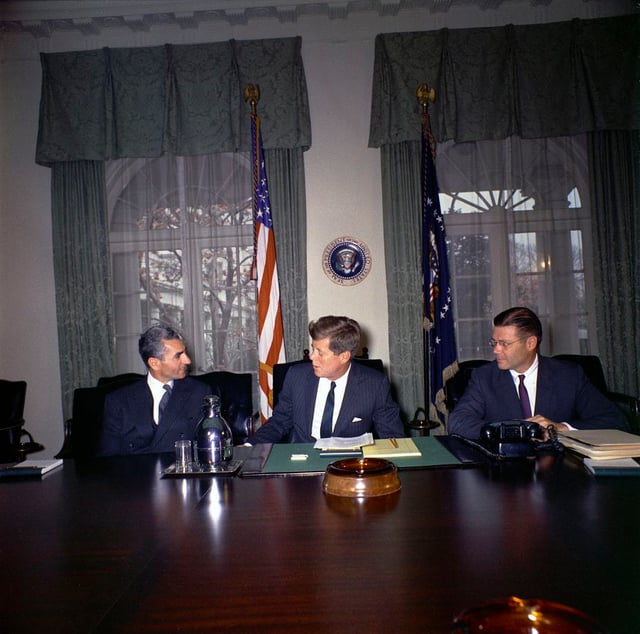
Mohammad Reza, U.S. President John F. Kennedy, and Secretary of Defense Robert McNamara in the White House Cabinet Room, 1962
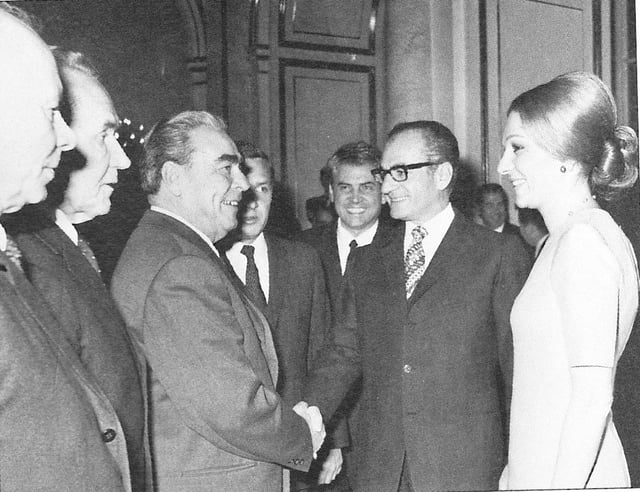
The Pahlavis meeting with general secretary Leonid Brezhnev in Moscow, 1970
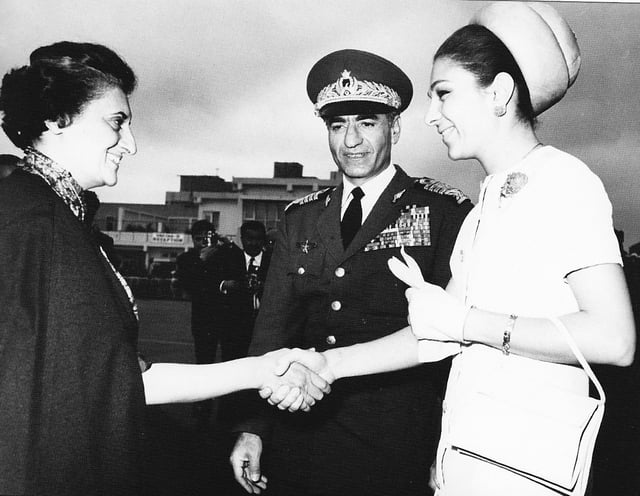
The Shah with his wife Farah meets Indira Gandhi in India, 1970

Mohammad Reza speaks with Richard Nixon in the Oval Office, 1973
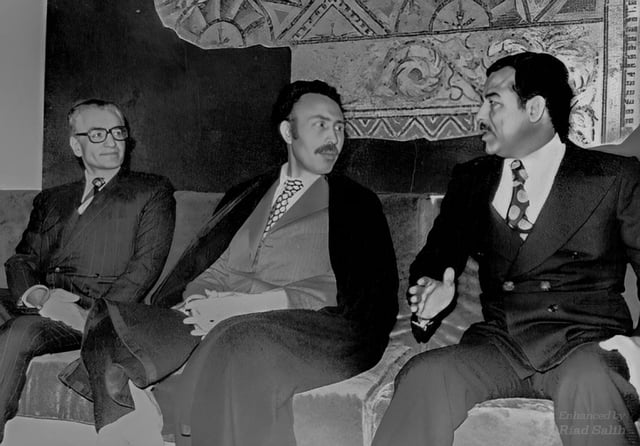
The Shah meeting Algerian President Houari Boumediène and Iraqi Vice President Saddam Hussein in Algiers in order to sign the 1975 Algiers Agreement
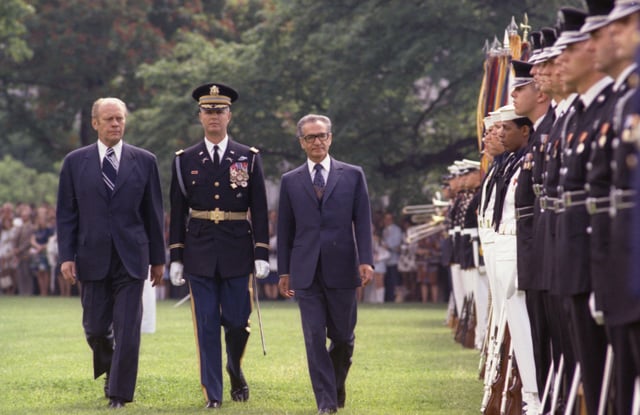
Mohammad Reza and Gerald Ford on the South Lawn, 1975
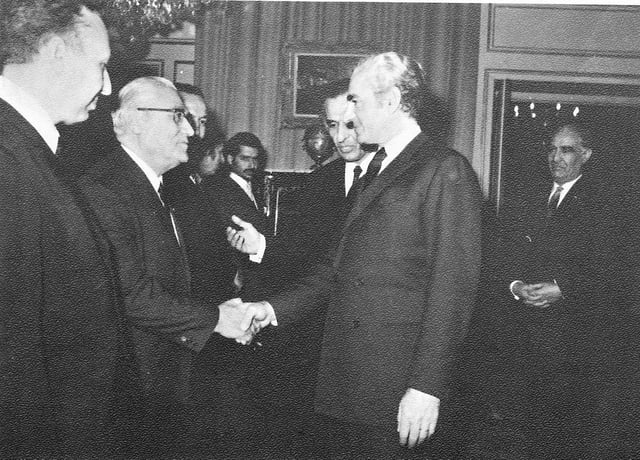
Mohammad Reza shakes hands with members of OPEC in a landmark session in Tehran, 1970
In 1961, the Francophile Mohammad Reza visited Paris to meet his favourite leader, General Charles de Gaulle of France.[17] Mohammad Reza saw height as the measure of a man and a woman (the Shah had a marked preference for tall women) and the 6'5" de Gaulle was his most admired leader. Mohammad Reza loved to be compared to his "ego ideal" of General de Gaulle, and his courtiers constantly flattered him by calling him Iran's de Gaulle.[17] During the French trip, Queen Farah, who shared her husband's love of French culture and language, befriended the culture minister André Malraux, who arranged for the exchange of cultural artifacts between French and Iranian museums and art galleries, a policy that remained a key component of Iran's cultural diplomacy until 1979.[17] Many of the legitimising devices of the regime such as the constant use of referendums were modelled after de Gaulle's regime.[17] Intense Francophiles, Mohammad Reza and Farah preferred to speak French rather than Persian to their children.[17] Mohammad Reza built the Niavaran Palace which took up 9, 000 square feet and whose style was a blend of Persian and French architecture.[17]
The Shah's diplomatic foundation was the United States' guarantee that it would protect his regime, enabling him to stand up to larger enemies.
While the arrangement did not preclude other partnerships and treaties, it helped to provide a somewhat stable environment in which Mohammad Reza could implement his reforms.
Another factor guiding Mohammad Reza in his foreign policy was his wish for financial stability, which required strong diplomatic ties.
A third factor was his wish to present Iran as a prosperous and powerful nation; this fuelled his domestic policy of Westernisation and reform.
A final component was his promise that communism could be halted at Iran's border if his monarchy was preserved.
By 1977, the country's treasury, the Shah's autocracy, and his strategic alliances seemed to form a protective layer around Iran.[165]
Although the U.S. was responsible for putting the Shah in power, he did not always act as a close American ally.
In the early 1960s, when the State Department's Policy Planning Staff that included William R. Polk encouraged the Shah to distribute Iran's growing revenues more equitably, slow the rush toward militarisation, and open the government to political processes, he became furious and identified Polk as "the principal enemy of his regime." In July 1964, the Shah, Turkish President Cemal Gürsel, and Pakistani President Ayub Khan announced in Istanbul the establishment of the Regional Cooperation for Development (RCD) organisation to promote joint transportation and economic projects. It also envisioned Afghanistan's joining at some time in the future. The Shah was the first regional leader to recognise the State of Israel as a de facto state, although when interviewed on 60 Minutes by reporter Mike Wallace, he criticised American Jews for their presumed control over U.S. media and finance.[166] In a 1967 memo to President Lyndon B. Johnson, U.S. Defense Secretary Robert McNamara wrote that "our sales [to Iran] have created about 1.4 million man-years of employment in the U.S. and over $1 billion in profits to American industry over the last five years," leading him to conclude that Iran was an arms market the United States could not do without.[167] In June 1965, after the Americans proved reluctant to sell Mohammad Reza some of the weapons he asked for, the Shah visited Moscow, where the Soviets agreed to sell some $110 million worth of weaponry; the threat of Iran pursuing the "Soviet option" caused the Americans to give in on selling Iran weapons.[167] Additionally, British, French, and Italian arms firms were willing to sell Iran weapons, thus giving Mohammad Reza considerable leverage in his talks with the Americans, who sometimes worried that the Shah was buying more weapons than Iran needed or could handle.[167]
Concerning the fate of Bahrain (which Britain had controlled since the 19th century, but which Iran claimed as its own territory) and three small Persian Gulf islands, the Shah negotiated an agreement with the British, which, by means of a public consensus, ultimately led to the independence of Bahrain (against the wishes of Iranian nationalists). In return, Iran took full control of Greater and Lesser Tunbs and Abu Musa in the Strait of Hormuz, three strategically sensitive islands which were claimed by the United Arab Emirates. During this period, the Shah maintained cordial relations with the Persian Gulf states and established close diplomatic ties with Saudi Arabia. Mohammad Reza saw Iran as the natural dominant power in the Persian Gulf region, and tolerated no challenges to Iranian hegemony, a claim that was supported by a gargantuan arms-buying spree that started in the early 1960s.[168] Mohammad Reza supported the Yemeni royalists against republican forces in the Yemen Civil War (1962–70) and assisted the sultan of Oman in putting down a rebellion in Dhofar (1971). In 1971, Mohammad Reza told a journalist: "World events were such that we were compelled to accept the fact that sea adjoining the Oman Sea—I mean the Indian Ocean—does not recognise borders. As for Iran's security limits—I will not state how many kilometers we have in mind, but anyone who is acquainted with geography and the strategic situation, and especially with the potential air and sea forces, know what distances from Chah Bahar this limit can reach".[169]
Iran's elations with Iraq, however, were often difficult due to political instability in the latter country.
Mohammad Reza was distrustful of both the Socialist government of Abd al-Karim Qasim and the Arab nationalist Baath party. He resented the internationally recognised Iran-Iraq border on the Shatt al-Arab river, which a 1937 treaty fixed on the low watermark on the Iranian side, giving Iraq control of most of the Shatt al-Arab.[23]Majestic%20Failure%3A%20The%20Fall%20of%20the%20]]On 19 April 1969, the Shah abrogated the treaty, and as a result Iran ceased paying tolls to Iraq when its ships used the Shatt al-Arab, costing Iraq a lucrative source of income.[171]%2C%20Lond]]He justified his move by arguing that almost all river borders all over the world ran along the (deep channel mark), and by claiming that because most of the ships that used the Shatt al-Arab were Iranian, the 1937 treaty was unfair to Iran.[172]%2C%20]]Iraq threatened war over the Iranian move, but when on 24 April 1969 an Iranian tanker escorted by Iranian warships sailed down the Shatt al-Arab without paying tolls, Iraq, being the militarily weaker state, did nothing.[173]%2C%20Lond]]The Iranian abrogation of the 1937 treaty marked the beginning of a period of acute Iraqi-Iranian tension that was to last until the Algiers Accords of 1975.[[173]](https://openlibrary.org/search?q=Karsh%2C%20Efraim.%20* [[CITE|171|https://openlibrary.org/search?q=Karsh%2C%20Efraim.%20The%20Iran-Iraq%20War%201980%E2%80%931988%2C%20Lond)Teymur Bakhtiar[17] n his diary that Mohammad Reza rejoiced at the news.[17]
On 7 May 1972, Mohammad Reza told a visiting President Richard Nixon that the Soviet Union was attempting to dominate the Middle East via its close ally Iraq, and that to check Iraqi ambitions would also be to check Soviet ambitions.[17] Nixon agreed to support Iranian claims to have the thalweg in the Shatt al-Arab recognised as the border and to generally back Iran in its confrontation with Iraq.[17] Mohammad Reza financed Kurdish separatist rebels in Iraq, and to cover his tracks, armed them with Soviet weapons which Israel had seized from Soviet-backed Arab regimes, then handed over to Iran at the Shah's behest. The initial operation was a disaster, but the Shah continued attempts to support the rebels and weaken Iraq. Then, in 1975, the countries signed the Algiers Accord, which granted Iran equal navigation rights in the Shatt al-Arab as the thalweg was now the new border, while Mohammad Reza agreed to end his support for Iraqi Kurdish rebels.[177] The Shah also maintained close relations with King Hussein of Jordan, President Anwar Sadat of Egypt, and King Hassan II of Morocco.[178] Starting in 1970, Mohammad Reza formed an unlikely alliance with the militantly left-wing regime of Colonel Muammar Gaddafi of Libya, as both leaders wanted higher oil prices for their nations, leading Iran and Libya joining forces to press for the "leapfrogging" of oil prices.[23]
The U.S.-Iran relationship grew more contentious as the U.S. became more dependent on Mohammad Reza to be a stabilising force in the Middle East. In a July 1969 visit to Guam, President Nixon had announced the Nixon Doctrine, which declared that the United States would honour its treaty commitments in Asia, but "as far as the problems of international security are concerned... the United States is going to encourage and has a right to expect that this problem will increasingly be handled by, and the responsibility for it taken by, the Asian nations themselves."[167] The particular Asian nation the Nixon Doctrine was aimed at was South Vietnam, but the Shah seized upon the doctrine, with its message that Asian nations should be responsible for their own defence, to argue that the Americans should sell him arms without limitation, a suggestion that Nixon embraced.[167] A particular dynamic was established in American-Iranian relations from 1969 onward, in which the Americans gave in to whatever Mohammad Reza demanded, as they felt they needed a strong Iran as a pro-American force in the Middle East and could not afford to lose Iran as an ally.[180] Further adding to the Shah's confidence was the Sino-Soviet border conflict of 1969, which forced the Red Army to make a major redeployment to the Chinese border.[17] Mohammad Reza, who always feared the prospect of a Soviet invasion, welcomed the Sino-Soviet war and the resulting reduction of Red Army divisions along the Soviet-Iranian border as giving him more room internationally.[17]
Under Nixon, the United States finally agreed to sever all contact with any Iranians opposed to the Shah's regime, a concession that Mohammad Reza had been seeking since 1958.[17] The often very anti-American tone of the Iranian press was ignored because Mohammad Reza supported the U.S. in the Vietnam War and likewise the Americans ignored the Shah's efforts to raise oil prices, despite the fact it cost many American consumers more.[180] After 1969, a process of "reverse leverage" set in, when Mohammad Reza began to dictate to the United States as the Americans needed him more than he needed the Americans.[23] The American National Security Advisor Henry Kissinger wrote in 1982 that because of the Vietnam War, it was not politically possible in the 1970s for the United States to fight a major war: "There was no possibility of assigning any American forces to the Indian Ocean in the midst of the Vietnam War and its attendant trauma. Congress would have tolerated no such commitment; the public would not have supported it. Fortunately, Iran was willing to play this role."[23] Consequently, the Americans badly needed Iran as an ally, which allowed Mohammad Reza to dictate to them. This experience greatly boosted the Shah's ego, as he felt he was able to impose his will on the world's most powerful nation.[23]
The Americans initially rejected Mohammad Reza's suggestion that they join him in supporting the Iraqi Kurdish peshmerga fighting for independence on the grounds that an independent Kurdistan would inspire the Turkish Kurds to rebel, and they had no interest in antagonising the NATO member Turkey.[17] Some of the Shah's advisers also felt it was unwise to support the peshmerga, saying that if the Iraqi Kurds won independence, then the Iranian Kurds would want to join them. When Nixon and Kissinger visited Tehran in May 1972, the Shah convinced them to take a larger role in what had, up to then, been a mainly Israeli-Iranian operation to aid Iraqi Kurds in their struggles against Iraq, against the warnings of the CIA and State Department that the Shah would ultimately betray the Kurds. He did this in March 1975 with the signing of the Algiers Accord that settled Iraqi-Iranian border disputes, an action taken without prior consultation with the U.S., after which he cut off all aid to the Kurds and prevented the U.S. and Israel from using Iranian territory to provide them assistance.[183]
As a way of increasing pressure on Baghdad, the peshmerga had been encouraged by Iran and the U.S. to abandon guerrilla war for conventional war in April 1974, so the years 1974–75 saw the heaviest fighting between the Iraqi Army and the peshmerga. The sudden cut-off of Iranian support in March 1975 left the Kurds very exposed, causing them to be crushed by Iraq.[184] The British journalist Patrick Brogan wrote that "...the Iraqis celebrated their victory in the usual manner, by executing as many of the rebels as they could lay their hands on."[184] Kissinger later wrote in his memoirs that it was never the intention of the U.S. or Iran to see the peshmerga actually win, as an independent Kurdistan would have created too many problems for both Turkey and Iran; rather, the intention was to "irritate" Iraq enough to force the Iraqis to change their foreign policy.[17]
The Shah also used America's dependence on Middle Eastern oil as leverage; although Iran did not participate in the 1973 oil embargo, he purposely increased production in its aftermath to capitalise on the higher prices. In December 1973, only two months after oil prices were raised by 70 per cent, he urged OPEC nations to push prices even higher, which they agreed to do, more than doubling the price. Oil prices increased 470 per cent over a 12-month period, which also increased Iran's GDP by 50 per cent. Despite personal pleas from President Nixon, the Shah ignored any complaints, claimed the U.S. was importing more oil than any time in the past, and proclaimed that "the industrial world will have to realise that the era of their terrific progress and even more terrific income and wealth based on cheap oil is finished."[183]
Modernisation and evolution of government

After opening the Micro-wave station, the Shah visits its different departments, 1970
With Iran's great oil wealth, the Shah became the preeminent leader of the Middle East, and self-styled "Guardian" of the Persian Gulf. In 1961 he defended his style of rule, saying "When Iranians learn to behave like Swedes, I will behave like the King of Sweden."[185]
During the last years of his regime, the Shah's government became more autocratic.
In the words of a U.S.
Embassy dispatch: "The Shah's picture is everywhere.
The beginning of all film showings in public theaters presents the Shah in various regal poses accompanied by the strains of the National Anthem...
The monarch also actively extends his influence to all phases of social affairs... there is hardly any activity or vocation in which the Shah or members of his family or his closest friends do not have a direct or at least a symbolic involvement.
In the past, he had claimed to take a two-party system seriously and declared, 'If I were a dictator rather than a constitutional monarch, then I might be tempted to sponsor a single dominant party such as Hitler organised'."[186]
However, by 1975, Mohammad Reza had abolished the two-party system of government in favour of a one-party state under the Rastakhiz (Resurrection) Party. This was the merger of the New Iran Party,[187] a centre-right party, and the People's Party,[188] a liberal party. The Shah justified his actions by declaring: "We must straighten out Iranians' ranks. To do so, we divide them into two categories: those who believe in Monarchy, the constitution and the Six Bahman Revolution and those who don't... A person who does not enter the new political party and does not believe in the three cardinal principles will have only two choices. He is either an individual who belongs to an illegal organisation, or is related to the outlawed Tudeh Party, or in other words a traitor. Such an individual belongs to an Iranian prison, or if he desires he can leave the country tomorrow, without even paying exit fees; he can go anywhere he likes, because he is not Iranian, he has no nation, and his activities are illegal and punishable according to the law."[189] In addition, the Shah had decreed that all Iranian citizens and the few remaining political parties become part of Rastakhiz.[190]
Image and self-image of Mohammad Reza in the 1970s
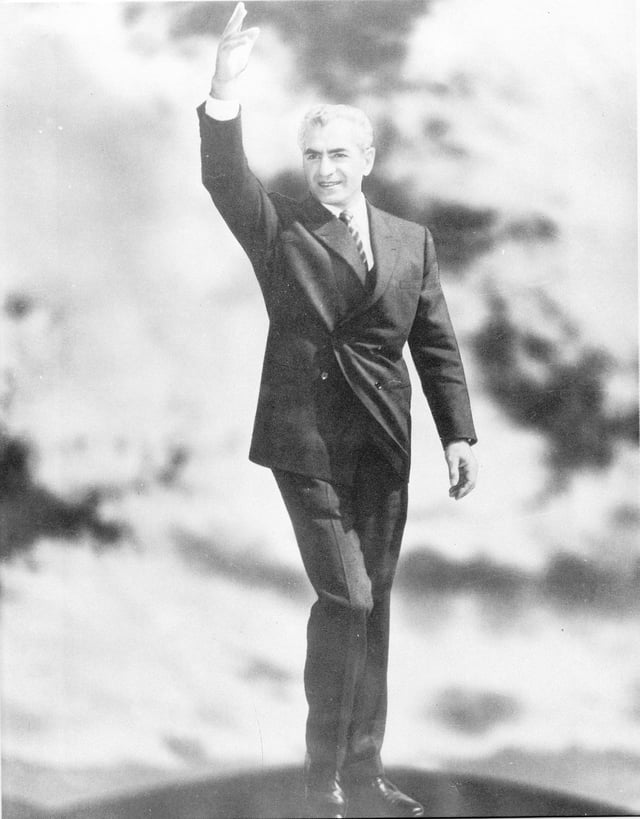
The Shah greeting the people – advertising his White Revolution as a step towards modernisation, photograph from 1963

Mohammad Reza and Farah with King Hassan II during their state visit to Morocco, 1966
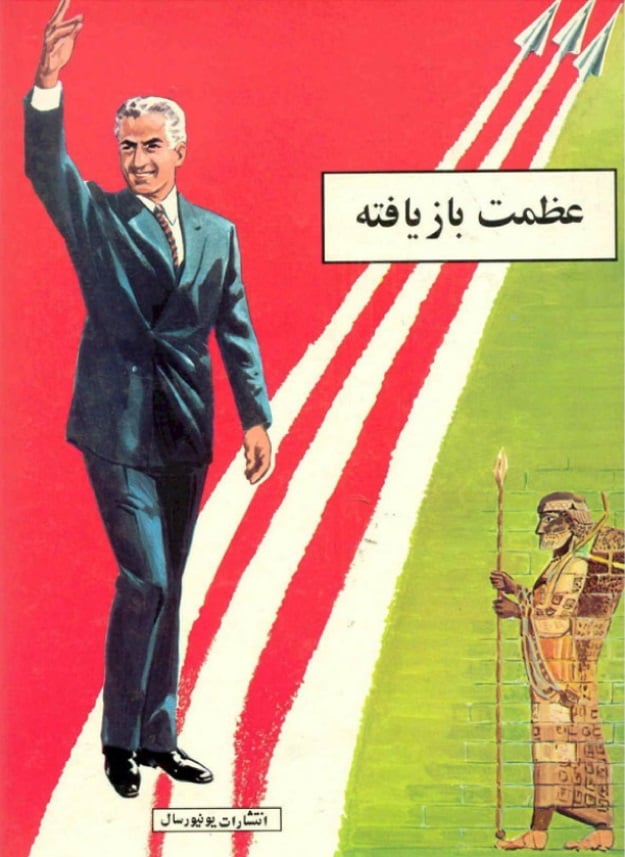
Cover of The Regained Glory, a biography of Mohammad Reza, 1976. Like much of the imagery surrounding Mohammad Reza, the cover references the Achaemenid period.
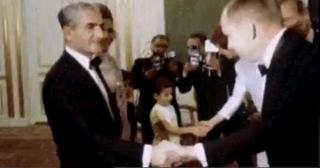
Lunar astronaut Neil Armstrong meeting the Shah of Iran during visit of Apollo 11 astronauts to Tehran on 28–31 October 1969[202]
From 1973 onward, Mohammad Reza had proclaimed his aim as that of the tamaddon-e-bozorg, the "Great Civilisation," a turning point not only in Iran's history, but also the history of the entire world, a claim that was taken seriously for a time in the West.[23]Majestic%20Failure%3A%20The%20Fall%20of%20the%20]]On 2 December 1974, the Paul Erdman was a conjectural future history entitled "The Oil War of 1976: How The Shah Won the World: The World as We Knew It Came to an End When the Shah Of Iran Decided to Restore The Glory of Ancient Persia with Western Arms".[23] In 1975, U.S. Vice President Nelson Rockefeller declared in a speech: "We must take His Imperial Majesty to the United States for a couple of years so that he can teach us how to run a country."[17] In 1976 a pulp novel by Alan Williams was published in the United States under the title A Bullet for the Shah: All They Had To Do Was Kill the World's Most Powerful Man, whose sub-title reveals much about how the American people viewed the Shah at the time (the original British title was the more prosaic Shah-Mak).[23]
The great wealth generated by Iran's oil encouraged a sense of nationalism at the Imperial Court.
The Empress Farah recalled of her days as a university student in 1950s France about being asked where she was from:
When I told them Iran... the Europeans would recoil in horror as if Iranians were barbarians and loathsome.
But after Iran became wealthy under the Shah in the 1970s, Iranians were courted everywhere.
Yes, Your Majesty.
Of course, Your Majesty.
If you please, Your Majesty.
Fawning all over us.
Greedy sycophants.
Then they loved Iranians.[23]
Mohammad Reza shared the Empress's sentiments as Westerners came begging to his court looking for his largesse, leading him to remark in 1976:
Now we are the masters and our former masters are our slaves.
Everyday they a beat a track to our door begging for favors.
How can they be of assistance?
Do we want arms?
Do we want nuclear power stations?
We have only to answer, and they will fulfill our wishes[23]
Because the House of Pahlavi were a parvenu house as Reza Khan had begun his career as a private in the Persian Army, rising up to the rank of general, taking power in a coup d'état in 1921, and making himself Shah in 1925, Mohammad Reza was keen to gain the approval of the older royal families of the world, and was prepared to spend large sums of money to gain that social acceptance.[17]
Amongst the royalty that came to Tehran looking for the Shah's generosity were King Hussein of Jordan, the former King Constantine II of Greece, King Hassan II of Morocco, the princes and princesses of the Dutch House of Orange, and the Italian Princess Maria Gabriella of Savoy, whom the Shah had once courted in the 1950s.[17] He coveted the British Order of the Garter, and had, prior to courting Maria Gabriella, inquired about marrying Princess Alexandra of Kent, granddaughter of King George V, but in both cases he was rebuffed in no uncertain terms.[17] As an Iranian, Mohammad Reza greatly enjoyed supporting the Greek branch of the House of Glücksburg, knowing the Greeks still celebrated their victories over the Persians in the 5th and 4th centuries BC.[17] He enjoyed close relations with Emperor Haile Selassie of Ethiopia, as demonstrated by the fact that he was the guest of honour at the Persepolis celebrations in 1971. Ethiopia and Iran, along with Turkey and Israel, were envisioned as an "alliance of the periphery" that would constrain Arab power in the greater Middle East.
In an era of high oil prices, Iran's economy boomed while the economies of the Western nations were trapped in stagflation (economic stagnation and inflation) after the 1973–74 oil shocks, which seemed to prove the greatness of Mohammad Reza both to himself and to the rest of the world.[23] In 1975, both the British Prime Minister Harold Wilson and the French President Valéry Giscard d'Estaing made pleading phone calls to Mohammad Reza asking him for loans, which ultimately led the Shah to give a $1 billion U.S. loan to the United Kingdom and another $1 billion U.S. to France.[23] In a televised speech in January 1975 explaining why he was lending Britain a sum equal to US$1 billion, Mohammad Reza declared in his usual grandiose style: "I have known the most dark hours when our country was obliged to pass under the tutelage of foreign powers, amongst them England. Now I find that England has not only become our friend, our equal, but also the nation to which, should we be able, we will render assistance with pleasure," going on to say that since he "belonged to this [European] world," he did not want Europe to collapse economically.[23]Majestic%20Failure%3A%20The%20Fall%20of%20the%20]]As Britain had often dominated Iran in the past, the change in roles was greatly gratifying to Mohammad Reza.[[197]](https://openlibrary.org/search?q=Zonis%2C%20Marvin.%20 [[CITE|23|https://openlibrary.org/search?q=Zonis%2C%20Marvin.%20*Majestic%20Failure%3A%20The%20Fall%20of%20the%20)
Courtiers at the Imperial court were devoted to stroking the Shah's ego, competing to be the most sycophantic, with Mohammad Reza being regularly assured he was a greater leader than his much admired General de Gaulle, that democracy was doomed, and that based on Rockefeller's speech, that the American people wanted Mohammad Reza to be their leader, as well as doing such a great job as Shah of Iran.[17] All of this praise boosted Mohammad Reza's ego, and he went from being a merely narcissistic man to a megalomaniac, believing himself a man chosen by Allah Himself to transform Iran and create the "Great Civilisation."[23]Majestic%20Failure%3A%20The%20Fall%20of%20the%20]][193]%2C%20London%3A%20Macmillan%2C%202011]]When one of the Shah's courtiers suggested launching a campaign to award him the Nobel Peace Prize, he wrote on the margin: "If they beg us, we might accept. They give the Nobel to ["any black face"] these days. Why should we belittle ourselves with this?"[[198]](https://openlibrary.org/search?q=Milani%2C%20Abbas.%20* [[CITE|17|https://openlibrary.org/search?q=Milani%2C%20Abbas.%20The%20Shah%2C%20London%3A%20Macmillan%2C%202011)Oriana Fallaci in a 1973 interview:
Halfway measures, compromises, are unfeasible.
In other words, either one is a revolutionary or one demands law and order.
One can't be a revolutionary with law and order.
And even less with tolerance... when Castro came to power, he killed at least 10, 000 people... in a sense, he was really capable, because he's still in power.
So am I, however!
And I intend to stay there, and to demonstrate that one can achieve a great many things by the use of force, show even that your old socialism is finished.
Old, obsolete, finished... I achieve more than the Swedes...
Huh!
Swedish socialism!
It didn't even nationalize forests and water.
But I have... my White Revolution... is a new original kind of socialism and... believe me, in Iran we're far more advanced than you and we really have nothing to learn from you.[23]
In an interview with Der Spiegel published on 3 February 1974, Mohammad Reza declared: "I would like you to know that in our case, our actions are not just to take vengeance on the West. As I said, we are going to be a member of your club".[23] In a press conference on March 31, 1974, Mohammad Reza predicted what Iran would be like in 1984, saying:
In the cities, electric cars would replace the gas engines and mass transportation systems would be switched to electricity, monorail over the ground or electric buses.
And, furthermore, in the great era of civilization that lies ahead of our people, there will be least two or three holidays a week.[23]
In 1976, Mohammad Reza told the Egyptian journalist Mohamed Hassanein Heikal in an interview: "I want the standard of living in Iran in ten years' time to be exactly on a level with that in Europe today. In twenty years' time we shall be ahead of the United States".[23]
Reflecting his need to have Iran seen as "part of the world" (by which Mohammad Reza meant the western world), all through the 1970s he sponsored conferences in Iran at his expense, with for example in one week in September 1975 the International Literacy Symposium meeting in Persepolis, the International Congress of Philosophy meeting in Mashhad and the International Congress of Mithraic Studies meeting in Tehran.[23] He also sought to hold the 1984 Summer Olympics in Tehran. For most ordinary Iranians, struggling with inflation, poverty, air pollution (Iranian cities were infamous in the 1970s as being amongst the most polluted in the world), having to pay extortion payments to the police who demanded money from even those performing legal jobs such as selling fruits on the street, and daily traffic jams, the Shah's sponsorship of international conferences were just a waste of money and time.[23][23] er than those of the United States and at the forefront of modern technology, he did not envision any political change, making it clear that Iran would remain an autocracy.[23]
Achievements
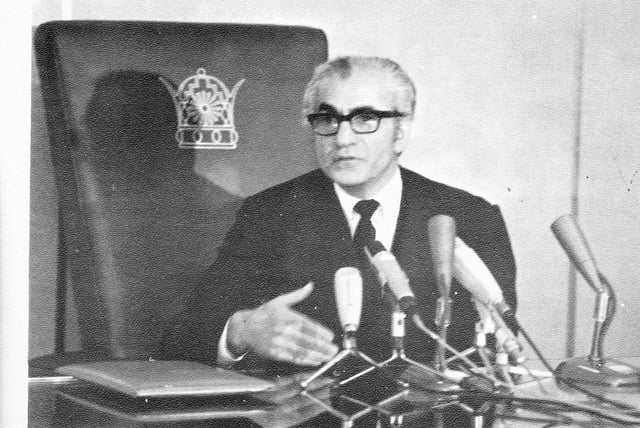
Mohammad Reza at a press conference in Niavaran Palace, 24 January 1971
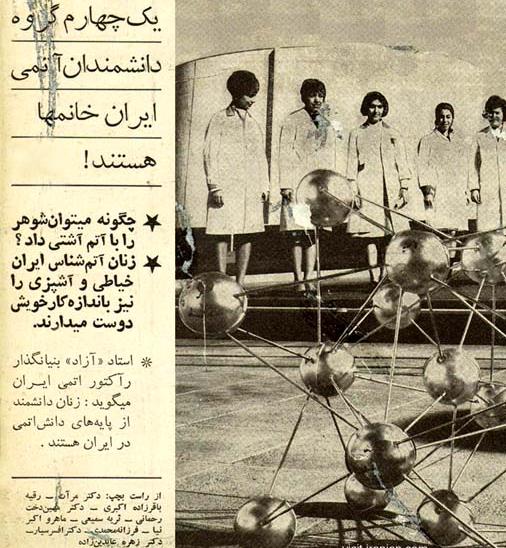
Iranian newspaper clip from 1968, reading: "A quarter of Iran's nuclear energy scientists are women", a marked change in women's rights.
In his "White Revolution" starting in the 1960s, Mohammad Reza made major changes to modernise Iran. He curbed the power of certain ancient elite factions by expropriating large and medium-sized estates for the benefit of more than four million small farmers. He took a number of other major measures, including extending suffrage to women and the participation of workers in factories through shares and other measures. In the 1970s the governmental programme of free-of-charge nourishment for children at school known as "Taghziye Rāyegan" (Persian: تغذیه رایگان lit. free nourishment) was implemented. Under the Shah's reign, the national Iranian income showed an unprecedented rise for an extended period.
Improvement of the educational system was made through the creation of new elementary schools.
In addition, literacy courses were set up in remote villages by the Imperial Iranian Armed Forces, this initiative being called "Sepāh-e Dānesh" (Persian: سپاه دانش) meaning "Army of Knowledge". The Armed Forces were also engaged in infrastructural and other educational projects throughout the country "Sepāh-e Tarvij va Ābādāni" (Persian: سپاه ترویج و آبادانی lit. army for promotion and development) as well as in health education and promotion "Sepāh-e Behdāsht" (Persian: سپاه بهداشت lit. army for hygiene'). The Shah instituted exams for Islamic theologians to become established clerics. Many Iranian university students were sent to and supported in foreign, especially Western, countries and the Indian subcontinent.
Between 1967 and 1977 the number of universities increased in number from 7 to 22, the number of institutions of advanced learning rose from 47 to 200, and the number of students in higher education soared from 36,742 to 100,000.
Iran's literacy programs were among the most innovative and effective anywhere in the world, so that by 1977 the number of Iranians able to read and write had climbed from just 17 percent to more than 50 percent.[206]
In the field of diplomacy, Iran realised and maintained friendly relations with Western and East European countries as well as the state of Israel and China and became, especially through its close friendship with the United States, more and more a hegemonial power in the Persian Gulf region and the Middle East. The suppression of the communist guerrilla movement in the region of Dhofar in Oman with the help of the Iranian army after a formal request by Sultan Qaboos was widely regarded in this context.
As to infrastructural and technological progress, the Shah continued and developed further the policies introduced by his father.
His programmes included projects in technologies such as steel, telecommunications, petrochemical facilities, power plants, dams and the automobile industry.
The Aryamehr University of Technology was established as a major new academic institution.[207][208][209]
International cultural cooperation was encouraged and organised, such as the 2,500 year celebration of the Persian Empire and Shiraz Arts Festival. As part of his various financial support programmes in the fields of culture and arts, the Shah, along with King Hussein of Jordan made a donation to the Chinese Muslim Association for the construction of the Taipei Grand Mosque.[210]
Revolution
Spark
The overthrow of the Shah came as a surprise to almost all observers.[211][212] The first militant anti-Shah demonstrations of a few hundred started in October 1977, after the death of Khomeini's son Mostafa.[213] On 7 January 1978, an article Iran and Red and Black Colonization was published in the newspaper Ettela'at attacking Ruhollah Khomeini, who was in exile in Iraq at the time; it referred to him as a homosexual, a drug addict, a British spy and claimed he was an Indian, not an Iranian.[214] Khomeini's supporters had brought in audio tapes of his sermons, and Mohammad Reza was angry with one sermon, alleging corruption on his part, and decided to hit back with the article, despite the feeling at the court, SAVAK and Ettela'at editors that the article was an unnecessary provocation that was going to cause trouble.[214] The next day, protests against the article began in the holy city of Qom, a traditional centre of opposition to the House of Pahlavi.[214]
Cancer patient
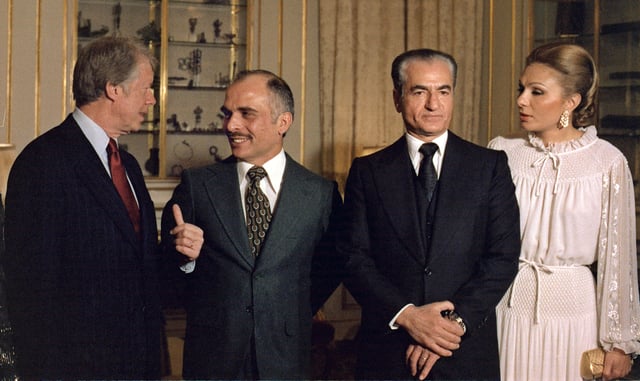
Mohammad Reza and Farah on their visit to the United States in 1977, with King Hussein and President Carter

Mohammad Reza Shah toasting with U.S.
Mohammad Reza was diagnosed with cancer in 1974.[23]Majestic%20Failure%3A%20The%20Fall%20of%20the%20]]As it worsened, from the spring of 1978, he stopped appearing in public, with the official explanation being that he was suffering from a "persistent cold."[[217]](https://openlibrary.org/search?q=Zonis%2C%20Marvin.%20 [[CITE|23|https://openlibrary.org/search?q=Zonis%2C%20Marvin.%20*Majestic%20Failure%3A%20The%20Fall%20of%20the%20)[23] pent the entire summer of 1978 at his Caspian Sea resort, where two of France's most prominent doctors, Jean Bernard and Georges Flandrin, treated his cancer.[23][23]
As nationwide protests and strikes swept Iran, the court found it impossible to get decisions from Mohammad Reza, as he became utterly passive and indecisive, content to spend hours listlessly staring into space as he rested by the Caspian Sea while the revolution raged.[23] The seclusion of the Shah, who normally loved the limelight, sparked all sorts of rumors about the state of his health and damaged the imperial mystique, as the man who had been presented as a god-like ruler was revealed to be fallible.[23] A July 1978 attempt to deny the rumors of Mohammad Reza's declining health (by publishing a crudely doctored photograph in the newspapers of the Emperor and Empress walking on the beach) instead further damaged the imperial mystique, as most people realised that what appeared to be two beach clogs on either side of the Shah were merely substitutes inserted for his airbrushed aides, who were holding him up as he now had difficulty walking by himself.[23]
In June 1978, Mohammad Reza's French doctors first revealed to the French government how serious his cancer was, and in September the French government informed the American government that the Shah was dying of cancer; until then, U.S. officials had no idea that Mohammad Reza had even been diagnosed with cancer four years earlier.[23] The Shah had created a very centralised system in which he was the key decision-maker on all issues, and as the Iranian-American historian Abbas Milani noted, he was mentally crippled in the summer of 1978 owing to his tendency to be indecisive when faced with a crisis which, combined with his cancer and the effects of the anti-cancer drugs, made his mood "... increasingly volatile and unpredictable. One day, he was full of verve and optimism and the next day or hour he fell into a catatonic stupor," bringing the entire government to a halt.[214] Milani wrote that the Shah was in 1978 "beset with depression, indecision and paralysis, and his indecision led to the immobilisation of the entire system."[214] Empress Farah grew so frustrated with her husband that she suggested numerous times that he leave Iran for medical treatment and appoint her regent, saying she would handle the crisis and save the House of Pahlavi. The macho Mohammad Reza vetoed this idea, saying he did not want Farah to be "Joan of Arc," and it would be too humiliating for him as a man to flee Iran and leave a woman in charge.[214]
Black Friday
The Shah-centred command structure of the Iranian military, and the lack of training to confront civil unrest, was marked by disaster and bloodshed.
There were several instances where army units had opened fire, the most notorious one being the events of 8 September 1978.
On this day, which later became known as "Black Friday", thousands had gathered in Tehran's Jaleh Square for a religious demonstration.
With people refusing to recognise martial law, the soldiers opened fire, killing and seriously injuring a large number of people.
Black Friday played a crucial role in further radicalising the protest movement.
The massacre so reduced the chance for reconciliation that Black Friday is referred to as "the point of no return" for the revolution.[222][223][224][225]%20by%20John%20Neubauer]][[226]](https://openlibrary.org/search?q= [[CITE|226|https://openlibrary.org/search?q=*Islam%20in%20the%20World%20Today%3A%20A%20Handbook%20of%20Politics%2C)[227][228] nts living abroad, including Ayatollah Khomeini.[229]
"Things fell apart, the centre cannot hold": the regime falls apart
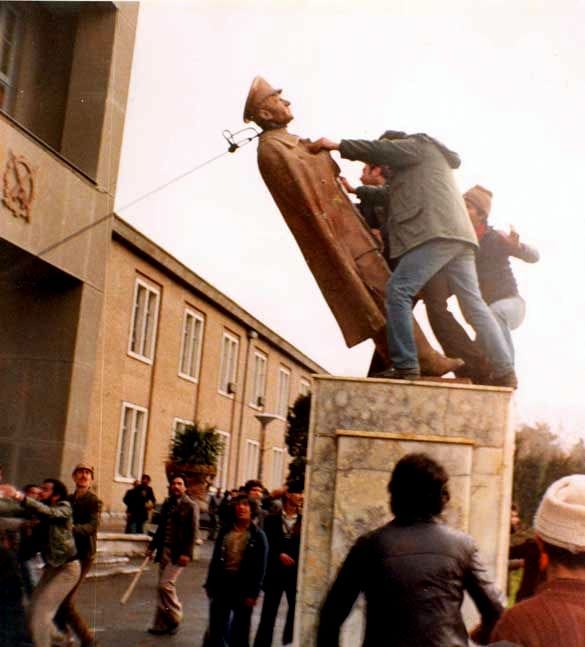
Supporters of the revolution remove a statue of the Shah in Tehran University, 1978
By October 1978, strikes were paralysing the country, and in early December a "total of 6 to 9 million"—more than 10% of the country—marched against the Shah throughout Iran.[230] In October 1978, after flying over a huge demonstration in Tehran in his helicopter, Mohammad Reza accused the British ambassador Sir Anthony Parsons and the American ambassador William H. Sullivan of organising the demonstrations, screaming that he was being "betrayed" by the United Kingdom and the United States.[214] The fact that the BBC's journalists tended to be very sympathetic towards the revolution was viewed by most Iranians, including Mohammad Reza, as a sign that Britain was supporting the revolution. This impression turned out to be crucial, as the Iranian people had a very exaggerated idea about Britain's capacity to "direct events" in Iran.[214] In a subsequent internal inquiry, the BBC found many of its more left-wing journalists disliked Mohammad Reza as a "reactionary" force, and sympathised with a revolution seen as "progressive".[214] Mohammad Reza spent much of his time working out various conspiracy theories about who was behind the revolution, with his favourite candidates being some combination of Britain, the United States and the Soviet Union.[214] Milani wrote that Mohamad Reza's view of the revolution as a gigantic conspiracy organised by foreign powers suggested that there was nothing wrong with Iran, and the millions of people demonstrating against him were just dupes being used by foreigners, a viewpoint that did not encourage concessions and reforms until it was too late.[214] For much of 1978, Mohammad Reza saw his enemies as "Marxist" revolutionaries rather than Islamists.[214] The Shah had exaggerated ideas about the power of the KGB, which he thought of as omnipotent, and often expressed the view that all of the demonstrations against him had been organised in Moscow, saying only the KGB had the power to bring out thousands of ordinary people to demonstrate.[17] In October 1978, the oil workers went on strike, shutting down the oil industry and with it, Mohammad Reza's principal source of revenue.[214] The Iranian military had no plans in place to deal with such an event, and the strike pushed the regime to the economic brink.[214]
The revolution had attracted support from a broad coalition ranging from secular, left-wing nationalists to Islamists on the right, and Khomeini, who was now based in Paris after being expelled from Iraq, chose to present himself as a moderate able to bring together all the different factions leading the revolution.[214] On 3 November a SAVAK plan to arrest about 1,500 people considered to be leaders of the revolution was submitted to Mohammad Reza, who at first tentatively agreed, but then changed his mind, disregarding not the only plan, but also dismissing its author, Parviz Sabeti.[17] On 5 November 1978, Mohammad Reza went on Iranian television to say "I have heard the voice of your revolution" and promise major reforms.[214] In a major concession to the opposition, on 7 November 1978, Mohammad Reza freed all political prisoners while ordering the arrest of the former prime minister Amir-Abbas Hoveyda and several senior officials of his regime, a move that both emboldened his opponents and demoralised his supporters.[15] On 21 November 1978, the Treasury Secretary of the United States Michael Blumenthal visited Tehran to meet Mohammad Reza and reported back to President Carter, "This man is a ghost", as by now the ravages of his cancer could not longer be concealed.[23] In late December 1978, the Shah learned that many of his generals were making overtures to the revolutionary leaders and the loyalty of the military could not longer be counted upon.[214] In a sign of desperation, the following month Mohammad Reza reached out to the National Front, asking if one of their leaders would be willing to become prime minister.[214]
The Shah was especially interested in having the National Front's Gholam Hossein Sadighi as prime minister.[214] Sadighi had served as interior minister under Mosaddegh, had been imprisoned after the 1953 coup, and had pardoned by Mohammad Reza on the grounds that he was a "patriot".[214] Sadighi remained active in the National Front and had often been harassed by SAVAK, but was willing to serve as prime minister under Mohammad Reza in order to "save" Iran, saying he feared what might come after if the Shah was overthrown.[214] Despite the opposition of the other National Front leaders, Sadighi visited the Niavaran palace several times in December 1978 to discuss the terms under which he might become prime minister, with the main sticking point being that he wanted the Shah not to leave Iran, saying he needed to remain in order to ensure the loyalty of the military.[214] On 7 December 1978, it was announced that President Carter of the U.S., President Giscard d'Estaing of France, Chancellor Schmidt of West Germany and Prime Minister Callaghan of the United Kingdom would meet in Guadeloupe on 5 January 1979 to discuss the crisis in Iran.[214] For Mohammad Reza this announcement was the final blow, and he was convinced that the Western leaders were holding the meeting to discuss how best to abandon him.[214]
End of monarchy
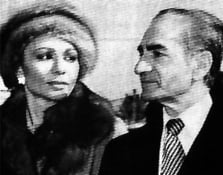
Shah Mohammad Reza and Shahbanu Farah shortly before leaving Iran in Mehrabad Airport, 1979.

Ettela'at newspaper in the hand of a revolutionary when Mohammad Reza and his family left Iran on January 16, 1979: "The Shah is Gone".
On 16 January 1979, Mohammad Reza made a contract with Farboud and left Iran at the behest of Prime Minister Shapour Bakhtiar (a longtime opposition leader himself), who sought to calm the situation.[247] As Mohammad Reza boarded the plane to take him out of Iran, many of the Imperial Guardsmen wept while Bakhtiar did little to hide his disdain and dislike for the Shah.[248]The%20Fighting%20Never%20Stopped%3A%20A%20Com]]Spontaneous attacks by members of the public on statues of the Pahlavis followed, and "within hours, almost every sign of the Pahlavi dynasty" was destroyed.[[249]](https://openlibrary.org/search?q=Taheri%2C%20 [[CITE|249|https://openlibrary.org/search?q=Taheri%2C%20Spirit%20%281985%29%2C%20p.%20240.)SAVAK er years in exile. He asked Khomeini to create a Vatican-like state in Qom, promised free elections, and called upon the opposition to help preserve the constitution, proposing a "national unity" government including Khomeini's followers. Khomeini rejected Bakhtiar's demands and appointed his own interim government, with Mehdi Bazargan as prime minister, stating that "I will appoint a state. I will act against this government. With the nation's support, I will appoint a state."[250] In February, pro-Khomeini revolutionary guerrilla and rebel soldiers gained the upper hand in street fighting, and the military announced its neutrality. On the evening of 11 February, the dissolution of the monarchy was complete.
Criticism of reign and causes of his overthrow

The Shah of Iran meets the clergy.
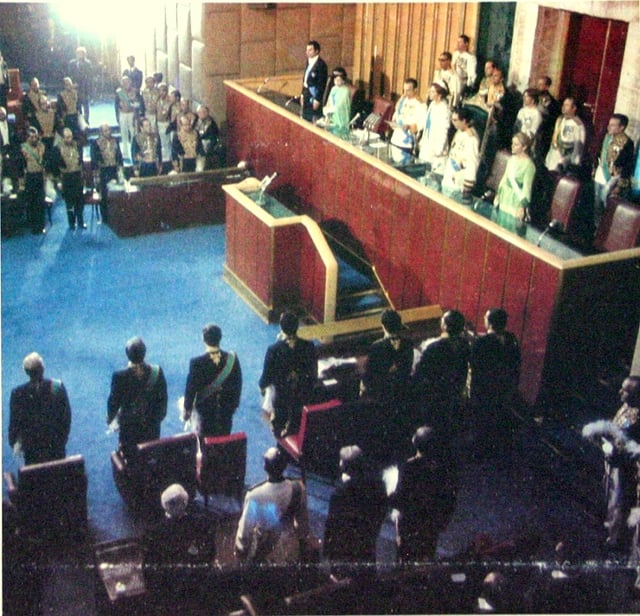
The Shah addressing the Iranian Senate, 1975

The Shah and the cabinet of Prime Minister Hassan Ali Mansur, Niavaran Palace, 1964
An Amnesty International assessment on Iran for 1974–1975 stated:
The shah of Iran retains his benevolent [world] image despite the highest rate of death penalties in the world, no valid system of civilian courts and a history of torture which is beyond belief.... the total number of political prisoners has been reported at times throughout the year [1975] to be anything from 25,000 to 100,000".[251][252]
At the Federation of American Scientists, John Pike writes:
In 1978 the deepening opposition to the Shah erupted in widespread demonstrations and rioting.
Recognising that even this level of violence had failed to crush the rebellion, the Shah abdicated the Peacock Throne and fled Iran on 16 January 1979. Despite decades of pervasive surveillance by SAVAK, working closely with CIA, the extent of public opposition to the Shah, and his sudden departure, came as a considerable surprise to the US intelligence community and national leadership. As late as 28 September 1978 the US Defense Intelligence Agency reported that the Shah "is expected to remain actively in power over the next ten years."[253]
Explanations for the overthrow of Mohammad Reza include his status as a dictator put in place by a non-Muslim Western power, the United States,[254][255] whose foreign culture was seen as influencing that of Iran. Additional contributing factors included reports of oppression, brutality,[256][257]%20by%20Ervand%20Abrahamia]]corruption, and extravagance.[256]%20%281998%29%2C%20pp.%2037%2C%2047%2C%2067%2C%20128%2C%20]][258]%20%281998%29%2C%20pp.%20236%2C%20260.]]Basic functional failures of the regime have also been blamed – economic bottlenecks, shortages and inflation; the regime's over-ambitious economic programme;[259]%20%281980%29%2C%20pp.%2019%2C%2096.]]the failure of its security forces to deal with protests and demonstrations;[260]%20%281980%29%20p.%20228.]]and the overly centralised royal power structure.[[261]](https://openlibrary.org/search?q=Arjomand%2C%20 [[CITE|261|https://openlibrary.org/search?q=Arjomand%2C%20Turban%20%281998%29%2C%20pp.%20189%E2%80%9390.)Organization of the Oil Producing Countries Jimmy Carter nomic ties between the United States of America and Saudi Arabia in the 1970s.[262]
In October 1971, Mohammad Reza celebrated the twenty-five-hundredth anniversary of the Iranian monarchy; The New York Times reported that $100 million was spent on the celebration.[263] Next to the ancient ruins of Persepolis, the Shah gave orders to build a tent city covering 160 acres (0.65 km2), studded with three huge royal tents and fifty-nine lesser ones arranged in a star-shaped design. French chefs from Maxim's of Paris prepared breast of peacock for royalty and dignitaries from around the world, the buildings were decorated by Maison Jansen (the same firm that helped Jacqueline Kennedy redecorate the White House), the guests ate off Limoges porcelain and drank from Baccarat crystal glasses. This became a major scandal, as the contrast between the dazzling elegance of the celebration and the misery of the nearby villages was so dramatic that no one could ignore it. Months before the festivities, university students went on strike in protest. Indeed, the cost was so sufficiently impressive that the Shah forbade his associates to discuss the actual figures. However he and his supporters argued that the celebrations opened new investments in Iran, improved relationships with the other leaders and nations of the world, and provided greater recognition of Iran.[264][265]
Other actions that are thought to have contributed to his downfall include antagonising formerly apolitical Iranians – especially merchants of the bazaars – with the creation in 1975 of a single party political monopoly (the Rastakhiz Party), with compulsory membership and dues, and general aggressive interference in the political, economic, and religious concerns of people's lives;[266] and the 1976 change from an Islamic calendar to an Imperial calendar, marking the conquest of Babylon by Cyrus as the first day, instead of the migration of Muhammad from Mecca to Medina. This supposed date was designed so that the year 2500 would fall on 1941, the year when his own reign started. Overnight, the year changed from 1355 to 2535.[267] During the extravagant festivities to celebrate the 2500th anniversary, the Shah was quoted as saying at Cyrus's tomb: "Rest in peace, Cyrus, for we are awake".[268]
It has been argued that the White Revolution was "shoddily planned and haphazardly carried out", upsetting the wealthy while not going far enough to provide for the poor or offer greater political freedom.[269]Blood%20%26%20Oil]]In 1974, Mohammad Reza learned from his French doctors that he was suffering from the cancer that was to kill him six years later.[[270]](https://openlibrary.org/search?q=Karsh%2C%20Effraim%20 [[CITE|270|https://openlibrary.org/search?q=Karsh%2C%20Effraim%20Islamic%20Imperialism%20A%20History%20New) e of it (as late as 1977 the CIA submitted a report to President Carter describing the Shah as being in "robust health"), the knowledge of his impending death left Mohammad Reza depressed and passive in his last years, a man no longer capable of acting.[270]
Some achievements of the Shah—such as broadened education—had unintended consequences.
While school attendance rose (by 1966 the school attendance of urban seven- to fourteen-year-olds was estimated at 75.8%), Iran's labour market could not absorb a high number of educated youth.
In 1966, high school graduates had "a higher rate of unemployment than did the illiterate", and the educated unemployed often supported the revolution.[271]
Exile
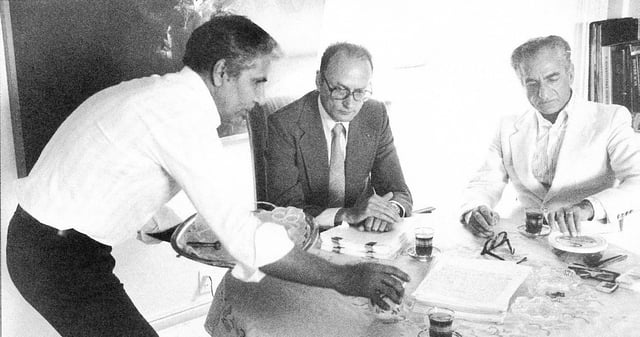
The Shah and Henry Boniet in Cuernavaca, Mexico, in 1979

Former U.S. President Richard Nixon visits Mohammad Reza Shah in exile, c. 1979
During his second exile, Mohammad Reza travelled from country to country seeking what he hoped would be temporary residence.
First he flew to Aswan, Egypt, where he received a warm and gracious welcome from President Anwar El-Sadat. He later lived in Marrakesh, Morocco as a guest of King Hassan II. Mohammad Reza loved to support royalty during his time as Shah and one of those who benefitted had been Hassan, who received an interest-free loan of US$110 million from his friend.[17] Mohammad Reza expected Hassan to return the favour, but he soon learned Hassan had other motives. Richard Parker, the American ambassador to Morocco reported "The Moroccans believed the Shah was worth about $2 billion, and they wanted to take their share of the loot".[17] After leaving Morocco, Mohammad Reza lived in Paradise Island, in the Bahamas, and in Cuernavaca, Mexico, near Mexico City, as a guest of José López Portillo. Richard Nixon, the former president, visited the Shah in summer 1979 in Mexico.[274] An American doctor, Benjamin Kean who examined Mohammad Reza in Cuernavaca later wrote:
There was no longer any doubt.
The atmosphere had changed completely.
The Shah's appearance was stunningly worse...
Clearly he had obstructive jaundice.
The odds favored gallstones, since his fever, chills and abdominal distress suggested an infection of the biliary tract.
Also he had a history of indigestion.
Besides the probable obstruction – he now had been deeply jaundiced for six to eight weeks – he was emaciated and suffering from hard tumor nodes in the neck and a swollen spleen, signs that his cancer was worsening, and he had severe anemia and very low white blood counts.[23]
The Shah suffered from gallstones that would require prompt surgery. He was offered treatment in Switzerland, but insisted on treatment in the United States. President Carter did not wish to admit Mohammad Reza to the U.S. but came under pressure from many quarters, with Henry Kissinger phoning Carter to say he would not endorse the SALT II treaty that Carter had just signed with the Soviet Union unless the former Shah was allowed into the United States, reportedly prompting Carter more than once to hang up his phone in rage in the Oval Office and shout "Fuck the Shah!".[17] As many Republicans were attacking the SALT II treaty as an American give-away to the Soviet Union, Carter was anxious to have the endorsement of a Republican elder statesman like Kissinger to fend off this criticism. Mohammad Reza had decided not to tell his Mexican doctors he had cancer, and the Mexican doctors had misdiagnosed his illness as malaria, giving him a regime of anti-malarial drugs that did nothing to treat his cancer, which caused his health to go into rapid decline as he lost 30 pounds.[17] In September 1979, a doctor sent by David Rockefeller reported to the State Department that Mohammad Reza needed to come to the United States for medical treatment, an assessment not shared by Kean, who stated that the proper medical equipment for treating Mohammad Reza's cancer could be found in Mexico and the only problem was the former Shah's unwillingness to tell the Mexicans he had cancer.[214] The State Department warned Carter not to admit the former Shah into the U.S., saying it was likely that the Iranian regime would seize the American embassy in Tehran if that occurred.[17] Milani suggested there was a possible conflict of interest on the part of Rockefeller, noting that his Chase Manhattan Bank had given Iran a $500 million loan under questionable conditions in 1978 (several lawyers had refused to endorse the loan) which placed the money in an account with Chase Manhattan, that the new Islamic republic had been making "substantial withdrawals" from its account with Chase Manhattan, and that Rockefeller wanted Mohammad Reza in the US, knowing full well it was likely to cause the Iranians to storm the U.S. embassy, which in turn would cause the U.S. government to freeze Iranian financial assets in America—such as the Iranian account at Chase Manhattan.[17]
On 22 October 1979, President Jimmy Carter reluctantly allowed the Shah into the United States to undergo surgical treatment at the New York Hospital–Cornell Medical Center. While there, Mohammad Reza used the name of "David D. Newsom", Under Secretary of State for Political Affairs at that time, as his temporary code name, without Newsom's knowledge. The Shah was taken later by US Air Force jet to Kelly Air Force Base in Texas and from there to Wilford Hall Medical Center at Lackland Air Force Base.[281] It was anticipated that his stay in the United States would be short; however, surgical complications ensued, which required six weeks of confinement in the hospital before he recovered. His prolonged stay in the United States was extremely unpopular with the revolutionary movement in Iran, which still resented the United States' overthrow of Prime Minister Mosaddegh and the years of support for the Shah's rule. The Iranian government demanded his return to Iran, but he stayed in the hospital.[282] Mohammad Reza's time in New York was highly uncomfortable; he was under a heavy security detail as every day, Iranian students studying in the United States gathered outside his hospital to shout "Death to the Shah!", a chorus that Mohammad Reza heard.[17] The former Shah was obsessed with watching news from Iran, and was greatly upset at the new order being imposed by the Islamic Republic.[17] Mohammad Reza could no longer walk by this time, and for security reasons had to be moved in his wheelchair under the cover of darkness when he went to the hospital while covered in a blanket, as the chances of his assassination were too great.[17]
There are claims that Reza's admission to the United States resulted in the storming of the U.S.
Embassy in Tehran and the kidnapping of American diplomats, military personnel, and intelligence officers, which soon became known as the Iran hostage crisis.[284]Legacy%20of%20Ashes%3A%20The%20History%20of%20the%20C]]In the Shah's memoir, Answer to History any kind of health care and asked him to leave the country.[285] From the time of the storming of the American embassy in Tehran and the taking of the embassy staff as hostages, Mohammad Reza's presence in the United States was viewed by the Carter administration as a stumbling block to the release of the hostages, and as Zonis noted "... he was, in effect, expelled from the country".[23]Majestic%20Failure%3A%20The%20Fall%20of%20the%20]]Mohammad Reza wanted to go back to Mexico, saying he had pleasant memories of Cuernavaca, but was refused.[[287]](https://openlibrary.org/search?q=Milani%2C%20Abbas.%20 [[CITE|17|https://openlibrary.org/search?q=Milani%2C%20Abbas.%20The%20Shah%2C%20London%3A%20Macmillan%2C%202011)rotating member of the UN Security Council Cuba Fidel Castro José López Portillo Cuba's vote was conditional on Mexico not accepting the Shah again.[17]
He left the United States on 15 December 1979 and lived for a short time in the Isla Contadora in Panama. This caused riots by Panamanians who objected to the Shah being in their country. General Omar Torrijos, the dictator of Panama kept Mohammad Reza as a virtual prisoner at the Paitilla Medical Center, a hospital condemned by the former Shah's American doctors as "an inadequate and poorly staffed hospital", and in order to hasten his death allowed only Panamanian doctors to treat his cancer.[23] General Torrijos, a populist left-winger had only taken in Mohammad Reza under heavy American pressure, and he made no secret of his dislike of Mohammad Reza, whom he called after meeting him "the saddest man he had ever met".[17] When he first met Mohammad Reza, Torrijos taunted him by telling him "it must be hard to fall off the Peacock Throne into Contadora" and called him a "chupon", a Spanish term meaning an orange that has all the juice squeezed out of it, which is slang for someone who is finished.[17]
Torrijos added to Mohammad Reza's misery by making his chief bodyguard a militantly Marxist sociology professor who spent much time lecturing Mohammad Reza on how he deserved his fate because he been a tool of the "American imperialism" that was oppressing the Third World, and charged Mohammad Reza a monthly rent of US$21,000, making him pay for all his food and the wages of the 200 National Guardsmen assigned as his bodyguards.[17] The new government in Iran still demanded his and his wife's immediate extradition to Tehran. A short time after Mohammad Reza's arrival in Panama, an Iranian ambassador was dispatched to the Central American nation carrying a 450-p. extradition request. That official appeal alarmed both the Shah and his advisors. Whether the Panamanian government would have complied is a matter of speculation amongst historians.[17]
The only consolation for Mohammad Reza during his time in Panama were letters from Princess Soraya saying that she still loved him and wanted to see him one last time before he died.[17] Mohammad Reza in the letters he sent to Paris declared he wanted to see Soraya one last time as well, but said that the Empress Farah could not be present, which presented some complications as Farah was continually by his deathbed.[17]
After that event, the Shah again sought the support of Egyptian president Anwar El-Sadat, who renewed his offer of permanent asylum in Egypt to the ailing monarch.
He returned to Egypt in March 1980, where he received urgent medical treatment, including a splenectomy performed by Michael DeBakey.[293] On 28 March 1980, Mohammad Reza's French and American doctors finally performed an operation meant to have been performed in the fall of 1979.[23] Kean recalled:
The operation went beautifully.
That night, however, was terrible.
The medical team-American, Egyptian, French-was in the pathology lab.
The focus was on the Shah's cancerous spleen, grotesquely swollen to 20 times normal.
It was one-foot long, literally the size of a football.
But I was drawn to the liver tissues that had also been removed.
The liver was speckled with white.
Malignancy.
The cancer had hit the liver.
The Shah would soon die...
The tragedy is that a man who should have had the best and easiest medical care had, in many respects, the worst.[23]
By that point, it was arranged by President Sadat that Soraya would quietly visit Mohammad Reza on his deathbed in Egypt without Farah present, but Milani noted the two were "star-crossed lovers" and Mohammad Reza died before Soraya could come to Egypt from her home in Paris.[17]
Death

Funeral of Mohammad Reza Pahlavi
In 1974 the Shah's doctor, Dr. Ayadi, diagnosed the Shah with splenomegaly after he complained of a swollen abdomen. On 1 May 1974, French Professor Georges Flandrin flew into Tehran to treat the Shah. Upon the first visit, Georges was able to diagnose the Shah with chronic lymphocytic leukemia. The Shah's diagnosis of cancer would not be revealed to him until 1978. Medical reports given to the Shah were falsified and altered in order to state that the Shah was in good health to conceal his cancer from him. The Shah later met with French physicians in 1976 in Zurich who were disturbed by the Shah's abnormal blood count. They discovered he was being treated with a wrong medication worsening his condition.[296]
In 1979 the Shah left Iran due to his decision to withhold military force on protesters.
First, the Shah found refuge in the Bahamas but was later forced to leave.
He then sought treatment in Mexico.
Multiple recommendations urged the Shah to seek treatment in the United States.
In response, the Shah stated
After some initial denials, the Shah agreed to travel to America for treatment.
After undergoing a botched operation, due to the negligence of the surgeons, the Shah left America for Panama.
While the Shah was in Panama, one of Khomeini's close advisors, Sadegh Ghotbzadeh had a meeting with Hamilton Jordan, Jimmy Carter's Chief of Staff.
Ghotbzadeh requested that the CIA kill the Shah while he was in Panama.
Fearing for his life, the Shah left Panama delaying further surgery.
He fled to Cairo, Egypt, with his condition worsening.
Finally, the Shah died on 27 July 1980 at age 60.
He kept a bag of Iranian soil under his death bed.[296]
Egyptian President Sadat gave the Shah a state funeral.[298] In addition to members of the Pahlavi family, Anwar Sadat, Richard Nixon and Constantine II of Greece attended the funeral ceremony in Cairo.[299]
Mohammad Reza is buried in the Al Rifa'i Mosque in Cairo, a mosque of great symbolic importance. Also buried there is Farouk of Egypt, Mohammad Reza's former brother-in-law. The tombs lie to the left of the entrance. Years earlier, his father and predecessor, Reza Shah had also initially been buried at the Al Rifa'i Mosque.
Legacy
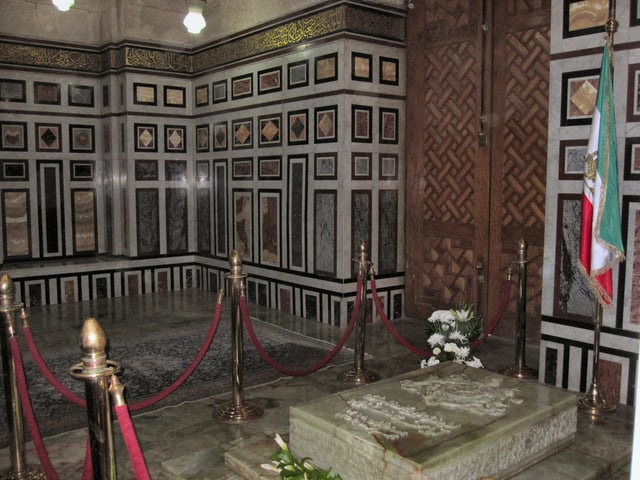
The interior of Mohammad Reza's tomb in Cairo's Al Rifa'i Mosque
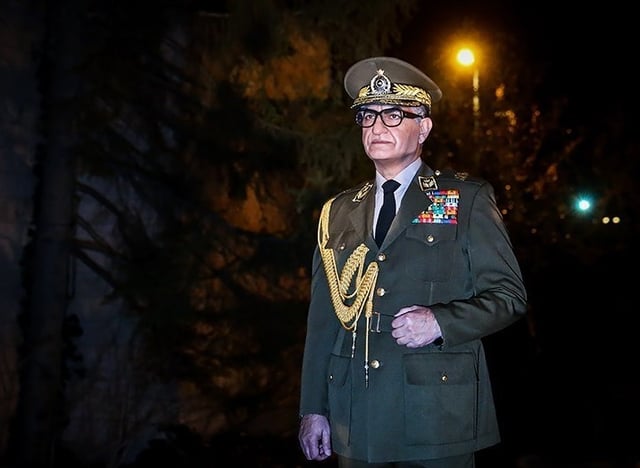
Amirmehdi Kia acting as a middle-aged Mohammad Reza in a TV series created in Iran, The Enigma of the Shah
In 1969, Mohammad Reza sent one of 73 Apollo 11 Goodwill Messages to NASA for the historic first lunar landing.[300] The message still rests on the lunar surface today. He stated in part, "we pray the Almighty God to guide mankind towards ever increasing success in the establishment of culture, knowledge and human civilisation". The Apollo 11 crew visited Mohammad Reza during a world tour.
Shortly after his overthrow, Mohammad Reza wrote an autobiographical memoir Réponse à l'histoire (Answer to History). It was translated from the original French into English, Persian (Pasokh be Tarikh), and other languages. However, by the time of its publication, the Shah had already died. The book is his personal account of his reign and accomplishments, as well as his perspective on issues related to the Iranian Revolution and Western foreign policy toward Iran. He places some of the blame for the wrongdoings of SAVAK, and the failures of various democratic and social reforms (particularly through the White Revolution), upon Amir Abbas Hoveyda and his administration.
Hussein-Ali Montazeri, who was once the designated successor to Ruhollah Khomeini, said that the Shah did not kill even 10 per cent of what Ruhollah Khomeini's regime had killed.[301] Recently, the Shah's reputation has experienced something of a revival in Iran, with some people looking back on his era as a time when Iran was more prosperous[302][303] and the government less oppressive.[304] Journalist Afshin Molavi reported that some members of the uneducated poor—traditionally core supporters of the revolution that overthrew the Shah—were making remarks such as, "God bless the Shah's soul, the economy was better then", and found that "books about the former Shah (even censored ones) sell briskly", while "books of the Rightly Guided Path sit idle".[302] On 28 October 2016, thousands of people in Iran celebrating Cyrus Day at the Tomb of Cyrus, chanted slogans in support of him, and against the current Islamic regime of Iran and Arabs, and many were subsequently arrested.[306]
Bibliography
Mohammad Reza published several books in the course of his kingship and two later works after his downfall.
Amongst others, these include:
Mission for My Country (1960)
The White Revolution (1967)
Toward the Great Civilisation (Persian version: Imperial 2536 = 1977 CE; English version: 1994)
Answer to History
The Shah's Story (1980)
Women's rights
Under Mohammad Reza's father, the government supported advancements by women against child marriage, polygamy, exclusion from public society, and education segregation. However, independent feminist political groups were shut down and forcibly integrated into one state-created institution, which maintained many paternalistic views. Despite substantial opposition from Shiite religious jurists, the Iranian feminist movement, led by activists such as Fatemah Sayyeh, achieved further advancement under Mohammad Reza. His regime's changes focused on the civil sphere, and private-oriented family law remained restrictive, although the 1967 and 1975 Family Protection Laws attempted to reform this trend.[307] During the reign of Shah, women gained the right to freely choose any profession, for example first female Iranian ministers such as Farrokhroo Parsa and judges such as Shirin Ebadi, while Mehrangiz Dowlatshahi became the first female cabinet member and ambassador of Iran. These activities alienated Islamic traditionalists and hastened the fall of the Shah.
Religious beliefs
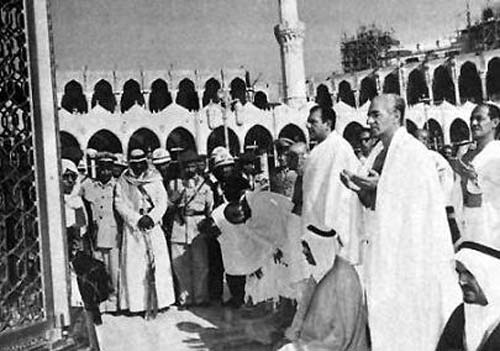
Mohammad Reza during his Hajj pilgrimage in the 1970s

The Shah and Shahbanu Farah Pahlavi visiting the Imam Reza shrine in Mashhad, the eighth Imam of Twelver Shiites, on June 1, 1978. Mohammad Reza Pahlavi was recognized as the last Shia Muslim king in Islamic history.
From his mother, Mohammad Reza inherited an almost messianic belief in his own greatness and that God was working in his favour, which explained the often passive and fatalistic attitudes that he displayed as an adult.[17] In 1973, Mohammad Reza told the Italian journalist Oriana Fallaci:
A king who does not need to account to anyone for what he says and does is unavoidably doomed to loneliness.
However, I am not entirely alone, because a force others can't perceive accompanies me.
My mystical force.
Moreover, I receive messages.
I have lived with God besides me since I was 5 years old.
Since, that is, God sent me those visions.[23]
Mohamed Reza often spoke in public and in private from childhood onward of his belief that God had chosen him for a "divine mission" to transform Iran, as he believed that dreams he had as a child of the Twelve Imams of Shia Islam were all messages from God.[23]Majestic%20Failure%3A%20The%20Fall%20of%20the%20]]In his 1961 book Mission for My Country*, Mohammad Reza wrote:
From the time I was six or seven, I have felt that perhaps there is a supreme being, who is guiding me.
I don't know.
Sometimes the thought disturbs me because then, I ask myself, what is my own personality, and am I possessed of free will?
Still, I often reflect, if I am driven-or perhaps I should say supported-by another force, there must be a reason.[23]
In his biography of the Shah, Marvin Zonis has argued that Mohammad Reza really believed in these claims of divine support. Shia Islam has no tradition of describing Shahs being favoured with messages from God, very few Shahs had ever claimed that their dreams were divine messages, and most people in the West laughed and snickered at Mohammad Reza's claim that his dreams were messages from God.[23]Majestic%20Failure%3A%20The%20Fall%20of%20the%20]]Reza Khan who was an atheist dismissed these visions as nonsense, and told his son to have more common sense.[[313]](https://openlibrary.org/search?q=Milani%2C%20Abbas.%20 [[CITE|15|https://openlibrary.org/search?q=Milani%2C%20Abbas.%20The%20Shah%2C%20London%3A%20Macmillan%202011%2C)
Fereydoon Hoveyda, a veteran diplomat who served as the Iranian ambassador to the United Nations (1971–1979), and the brother of Amir-Abbas Hoveyda, the Prime Minister under the Shah (1965–1977) executed after the Islamic revolution, and himself a critic of the régime who died in exile, says that "when it comes to religion and spirituality, many passages of the monarch's and Khomeini's publications are interchangeable", which he perceives as the continuity of the Iranian civilization, where the religion changes but the "spirit" remains.[314]
Wealth
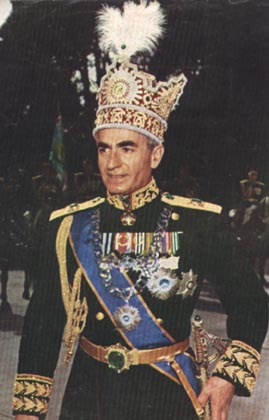
The newly crowned Shah with his Pahlavi Crown

The Shah of Persia, body by Carrozzeria Touring
Mohammad Reza inherited the wealth built by his father Reza Shah who preceded him as king of Iran and became known as the richest person in Iran during his reign, with his wealth estimated to be higher than 600 million rials[315] and including vast amounts of land and numerous large estates especially in the province of Mazandaran[316] obtained usually at a fraction of their real price.[317] Reza Shah, facing criticism for his wealth, decided to pass on all of his land and wealth to his eldest son Mohammad Reza in exchange for a sugar cube, known in Iran as habbe kardan.[318] However shortly after obtaining the wealth Mohammad Reza was ordered by his father and then king to transfer a million toman ($500,000) to each of his siblings.[319] By 1958 it was estimated that the companies possessed by Mohammad Reza had a value of $157 million (in 1958 USD) with an estimated additional $100 million saved outside Iran.[320] Rumours of his and his family's corruption began to surface which greatly damaged his reputation. This formed one of the reasons for the creation of the Pahlavi Foundation and the distribution of additional land to the people of some 2,000 villages inherited by his father, often at very low and discounted prices.[321] In 1958, using funds from inherited crown estates, Mohammad Reza established the Pahlavi Foundation which functioned as a tax-exempt charity and held all his assets, including 830 villages spanning a total area of 2.5 million hectares.[322] According to Business Insider, Mohammad Reza had set up the organisation "to pursue Iran's charitable interests in the U.S."[323] At its height, the organisation was estimated to be worth $3 billion, however, on numerous occasions, the Pahlavi Foundation was accused of corruption.[324][325] Despite these charges, in his book Answer to History, Pahlavi affirms that he "never made the slightest profit" out of the Foundation.[326]
In a 1974 interview which was shown in a documentary titled Crisis in Iran, Mohammad Reza told Mike Wallace that the rumours of corruption were "the most unjust thing that I have heard," calling them a "cheap accusation" whilst arguing the allegations were not as serious as those regarding other governments, including that of the United States.[327] In November 1978, after Pahlavi dismissed Prime Minister Jafar Sharif-Emami and appointed a military government, he pledged in a televised address "not to repeat the past mistakes and illegalities, the cruelty and corruption."[328] Despite this, the royal family's wealth can be seen as one of the factors behind the Iranian revolution. This was due to the oil crises of the 1970s which increased inflation resulting in economic austerity measures which made lower class workers more inclined to protest.[329]
Mohammad Reza's wealth remained considerable during his time in exile.
While staying in the Bahamas he offered to purchase the island that he was staying on for $425 million (in 1979 USD), however his offer was rejected by the Bahamas which claimed that the island was worth far more. On 17 October 1979, again in exile and perhaps knowing the gravity of his illness, he split up his wealth amongst his family members, giving 20% to Farah, 20% to his eldest son Reza, 15% to Farahnaz, 15% to Leila, 20% to his younger son, in addition to giving 8% to Shahnaz and 2% to his granddaughter Mahnaz Zahedi.[330]
On 14 January 1979, an article titled "Little pain expected in exile for Shah" by The Spokesman Review newspaper found that the Pahlavi dynasty had amassed one of the largest private fortunes in the world; estimated then at well over $1 billion.
It also stated that a document submitted to the ministry of justice, in protest of the royal family's activity in many sectors of the nation's economy, detailed the Pahlavis dominating role in the economy of Iran.
The list showed that the Pahlavi dynasty had interests in, amongst other things, 17 banks and insurance companies, including a 90 per cent ownership in the nation's third-largest insurance company, 25 metal enterprises, 8 mining companies, 10 building materials companies, including 25 per cent of the largest cement company, 45 construction companies, 43 food companies, and 26 enterprises in trade or commerce, including a share of ownership in almost every major hotel in Iran; the Pahlavis also has major interests in real estate.[331] Mohammad Reza was also known for his interest in cars and had a personal collection of 140 classic and sports car s including a Mercedes-Benz 500K Autobahn cruiser, one of only six ever made.[332] The first Maserati 5000 GT was named the Shah of Persia, it was built for Mohammad Reza, who had been impressed by the Maserati 3500 and requested Giulio Alfieri, Maserati's chief engineer, to use a modified 5-litre engine from the Maserati 450S on the 3500GT's chassis.[333]
Titles, styles, honours, arms and symbols
Titles, styles and honours
Mohammad Reza was Sovereign of many orders in Iran, and received honours and decorations from around the world.
Mohammad Reza used the style His Majesty until his imperial coronation in 1967, ascending to the title of Shahanshah, when he adopted the style His Imperial Majesty. Mohammad Reza also held many supplementary titles such as Bozorg Artestaran, a military rank superseding his prior position as Captain. On 15 September 1965, Mohammad Reza was granted the title of Aryamehr ('Light of the Aryans') by an extraordinary session of the joint Houses of Parliament.[334]
Arms
From 24 April 1926 until his accession, Mohammad Reza's arms notably consisted of two Shahbaz birds in the centre, a common symbol during the Achaemenid period, with the Pahlavi Crown placed above them. Upon his accession, he adopted his father's coat of arms which included a shield composed of the Lion and the Sun symbol in first quarter, the Faravahar in the second quarter, the two-pointed sword of Ali (Zulfiqar) in third quarter and the Simurgh in the fourth quarter. Overall in the centre is a circle depicting Mount Damavand with a rising sun, the symbol of the Pahlavi dynasty. The shield is crowned by the Pahlavi crown and surrounded by the chain of the Order of Pahlavi. Two lions rampant regardant, holding scimitars supports the coat of arms on either side. Under the whole device is the motto: "Mara dad farmud va Khod Davar Ast" ("Justice He bids me do, as He will judge me" or, alternatively, "He gave me power to command, and He is the judge").
Imperial symbols
The Pahlavi imperial family employed rich heraldry to symbolise their reign and ancient Persian heritage.
An image of the imperial crown was included in every official state document and symbol, from the badges of the armed forces to paper money and coinage.
The image of the crown was the centerpiece of the imperial standard of the Shah.
The personal standards consisted of a field of pale blue, the traditional colour of the Iranian imperial family, at the centre of which was placed the heraldic motif of the individual.
The Imperial Iranian national flag was placed in the top left quadrant of each standard.
The appropriate imperial standard was flown beside the national flag when the individual was present.
In 1971, new designs were adopted.[335]
See also
Human rights in the Pahlavi Dynasty
Mediterranean and Middle East Theatre
Monarchism in Iran
National Car Museum of Iran, showcases the cars of Mohammad Reza
Norman Schwarzkopf Sr.
Nuclear program of Iran
Tehran Conference
Trans-Iranian Railway
Guadeloupe conference


